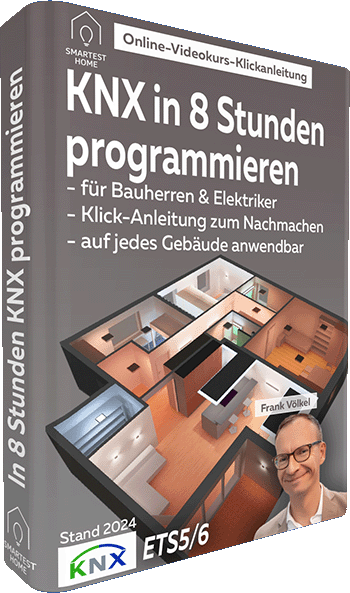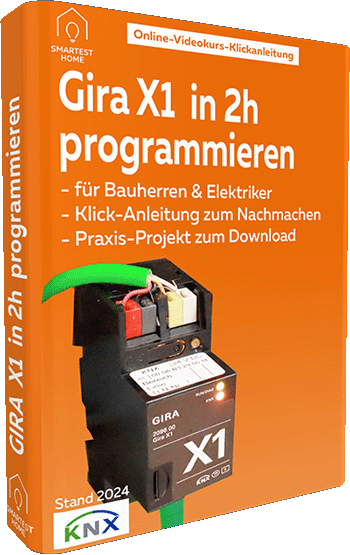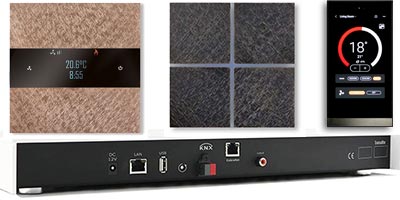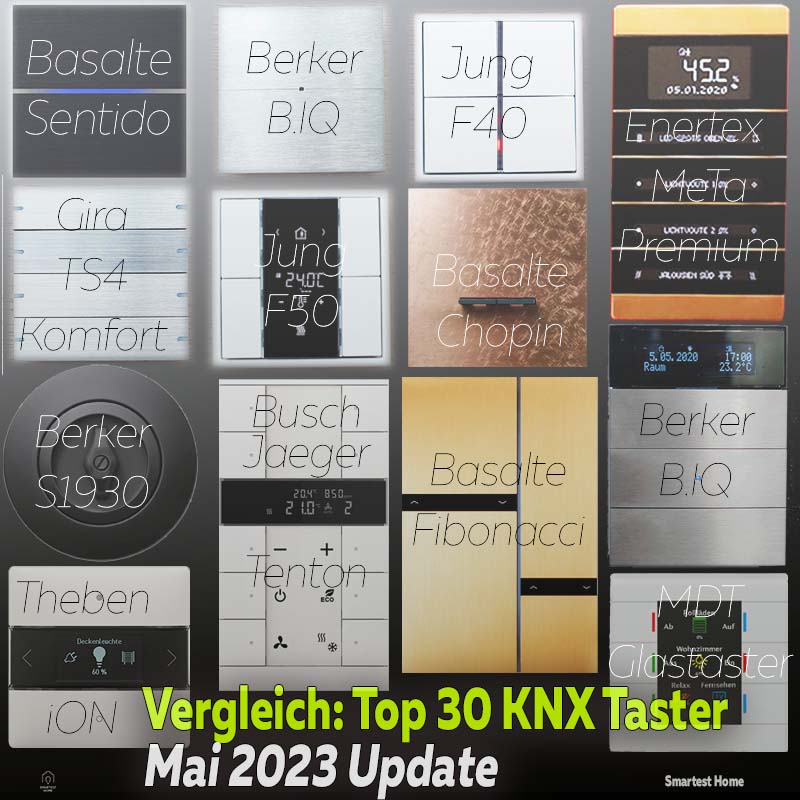
Table of contents Top 30 KNX push buttons
Which KNX push buttons are allowed to control the family house in the individual rooms in 2023? Or should we rather say KNX switch? Both terms mean the same thing – it’s about control in a networked house.
We compare the top 30 best KNX push buttons on the global market: Basalte Chopin, Basalte Fibonacci and Basalte Sentido, Berker B.IQ tactile sensor, Enertex MeTa KNX Premium, Gira tactile sensor 3 comfort and Gira tactile sensor 4 comfort, Jung F40 and Jung F50 tactile sensor as well Jung LS Touch, the long-running MDT Glastaster II smart, the invisible Enertex ProxyTouch KNX, Enertex MeTa Premium, Theben iON KNX and other innovations. Which KNX button is the right choice for a new building or an existing building? Which KNX buttons belong in a Smart Home Villa?
When it comes to high quality and workmanship, good design and aesthetics and as many functions as possible, then the KNX push buttons we have presented are a good basis for selection. The diversity of the KNX push button design is often an argument for builders to opt for a KNX Smart Home in a new building or for renovation.
And first of all: Choosing the most suitable KNX button is a decision for many years, often for several decades. Most of the KNX switches presented here are designed for long-term use in apartments, houses and villas and can be brought up to date with updates. It is definitely sustainable. Compared to other products in the electrical trades, looking back over the past 12 months, the price increases in 2022 were more moderate and are hardly noticeable. So if you are now looking for the right KNX button, you can count on reasonable purchase prices.
We update this overview weekly with current practical experiences, tests and findings. Current status of our comparison test: May 2023.
Purchase advice: Top 30 KNX push buttons - from 80€ to 1000€
There are currently 83 different manufacturers on the market – as of May 2023, who offer a total of around 1150 different KNX buttons or switches. No other smart home system in the world offers more choice, more variants in terms of quality, equipment and individual adaptation to the living situation, the ambience and the interior design!
A venerable villa on Lake Starnberg is just as well served as the minimalist wooden single-family house in the Tyrolean countryside or the corner terraced house with a lot of personal work by the builder in the outskirts of a big city.
We introduce you to the world’s best KNX buttons, which had to pass an extensive test run with us. What is this composition made up of? It is our practical experience with newly built houses, the very good knowledge of the market and the feedback from many builders that allow this top checklist of KNX switches/buttons to be created and constantly expanded.
From cheap to elegant and high-end: what can a KNX push button do?
Basic functions of KNX push buttons
- Regulate room temperature, automatically and manually
- Measurement of room temperature
- Measurement of room air humidity (optional)
- Measurement of room brightness (optional)
- Switch light, shading, ventilation, sockets at the push of a button
- Dim light, dim to warm, set colored light
- Call up scenes (light, blinds, music, switching functions, etc.) save scenes
- Room temperature display (KNX button with display)
- Status display (light, shading, day/night etc.)
- Display of error messages (KNX button with display)
- Day/night display switching (optional)
- Night light and orientation lighting (optional)
Anyone who knows a conventional light switch from the analog (and still today) time, for which a KNX button with its comparatively infinite capabilities is a small miracle. It can record values such as room temperature and room humidity, display the status of the individual buttons if required, or act as a night light or orientation light.
In principle, a KNX button is the control center in a room, where all things such as lighting, shading, heating/cooling, ventilation and switchable sockets are operated.
The advantage: Where previously endless switch batteries had to be placed, there is now a single KNX button. And it can do a lot more like the switch batteries that are still found in the larger residential buildings of many a property developer and unsuspecting electrician. The list above shows the basic options/functions that can be implemented with a KNX button of the year 2023.
By now it should be clear that a KNX button cannot be compared at all with a conventional switch and, thanks to its wide range of functions, always pays off in terms of budget.
Operation of the KNX push button: by click or touch?
In principle, there are two different ways of operating KNX buttons: One reacts to a button click (as a rocker or button) and the other to a mere touch (capacitive KNX buttons). And then there’s the exception with gesture control, which is limited to the Enertex ProxyTouch. Since the buttons are visible to everyone on the wall for many years – probably decades – and are also the figurehead of the respective room, you should proceed very carefully when selecting the right KNX button.
On the one hand, a KNX button can be replaced by another model at any time, but on the other hand there is the old adage: if you buy cheap or wrong, you buy twice.
Whether a room is operated by touching a button or by haptic click (sound) with feedback is still a matter of personal taste. We find that there are good representatives for one as well as the other concept. Curtain up for our big comparison of the best KNX buttons (or KNX switches) in the world, which is constantly updated.
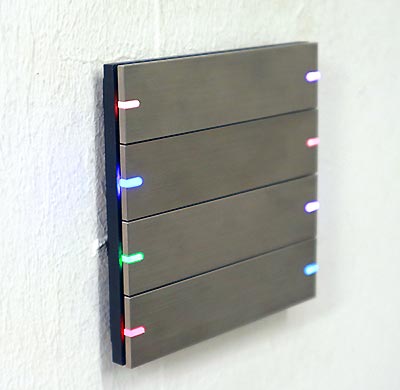
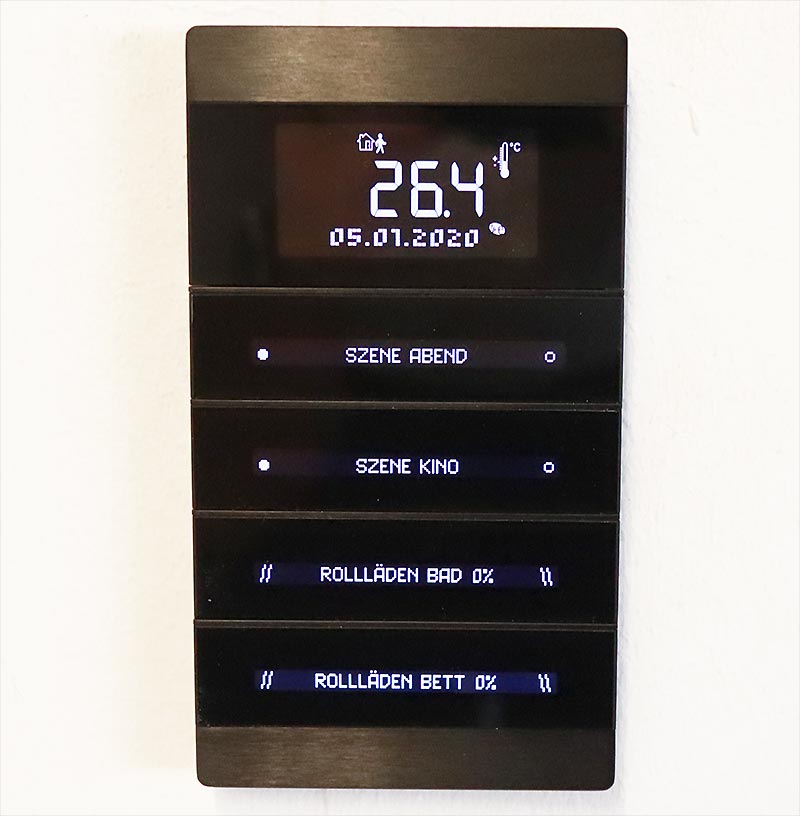
Differences in the equipment of current KNX push buttons:
- KNX push button with bus coupler (all have, as of 2023)
KNX push button with temperature sensor (all have, as of 2023)
KNX push button with humidity sensor (some now)
KNX push buttons with display (are no longer so trendy, as of 2023)
KNX push button with binary input (only very few)
KNX push button with electronic button labeling (only a few)
KNX push button with dimmable night light (have some, absolutely in trend 2023)
KNX push buttons with proximity sensor (have a few, very trendy in 2023)
Wall installation and connection: KNX push button or KNX switch
Just like a conventional switch in the room, each KNX button requires a 60 mm or 68 mm (diameter) socket for wall installation and an electrical connection cable. The box is to be milled into brick or sand-lime brick with the appropriate tool. With the KNX button, the power supply and the transmission of the data for switching etc. runs via the same cable: via the green KNX bus line with 29 volt direct voltage!
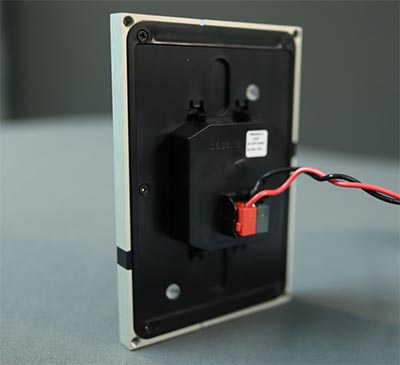
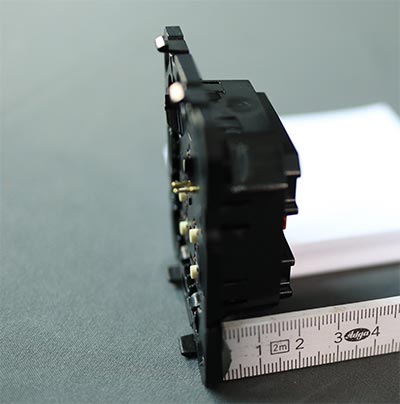
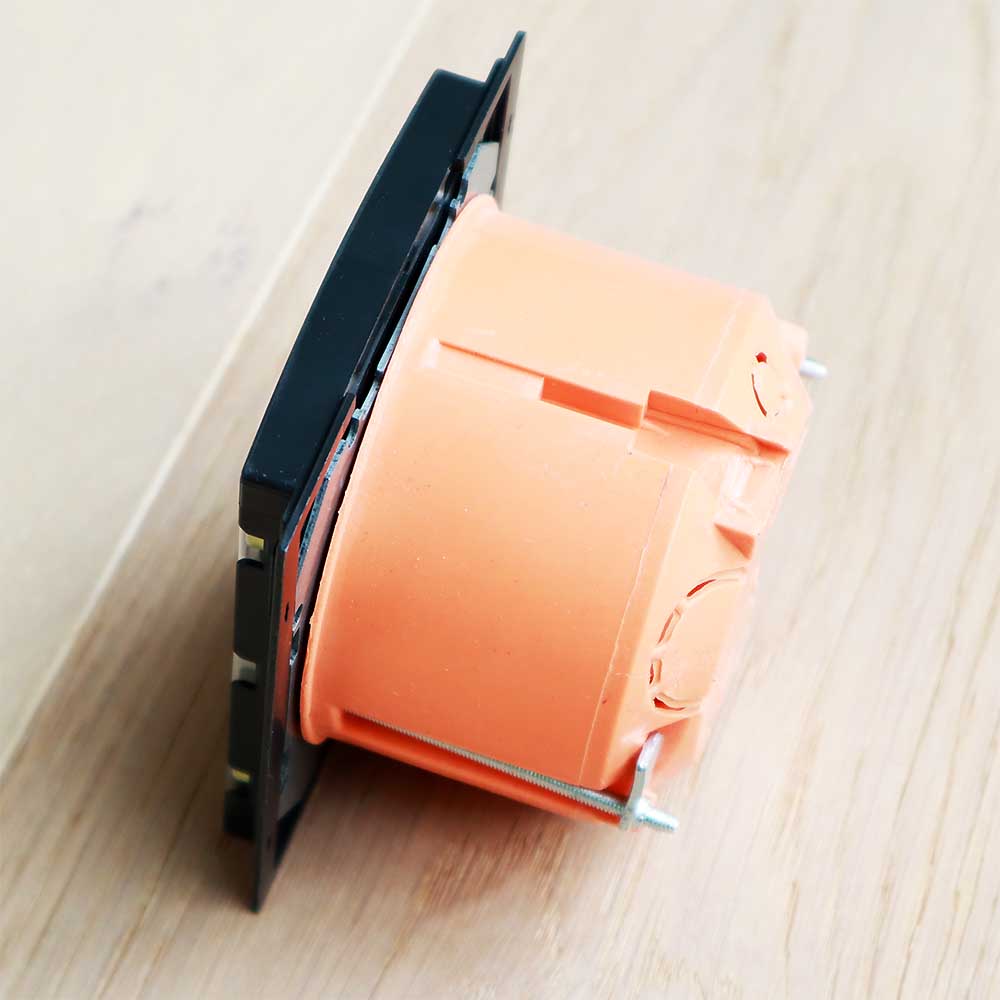
KNX push button with temperature sensor and room temperature controller
Let’s go into an important thing that all KNX buttons have in common: the integrated temperature sensor for measuring the room temperature. The latter is used to control the (floor) heating in conjunction with a KNX heating actuator located in the control cabinet.
Since all of the KNX buttons we tested here are equipped with a temperature sensor, the temperature can be measured in every room. In addition to the temperature sensor, some KNX buttons are also equipped with a room temperature controller – also referred to by the abbreviation “KNX button with RTC”.
From our point of view, KNX buttons with room temperature controllers are no longer trendy, since the heating controller is integrated in the KNX heating actuator (in the control cabinet). As a result, equipment with a temperature sensor is sufficient today.
Basalte Deseo RTR: For the highest demands - luxury
To get straight to the point: There is no KNX push button on the market that is more expensive than the Basalte Deseo with RTR – no matter which version we are now specifying in more detail. The “RTC” stands for room temperature controller, which many buttons also offer that cost only a fraction of the price. BUT: Its exclusivity in terms of material appearance, design, coloring and user ergonomics can be seen and guessed from afar. But what is the Deseo actually about? It’s about pure luxury that no other KNX button can exude!
In terms of price, the Basalte Deseo RTR scratches the four-digit euro mark, depending on the choice of material, without naming detailed prices here. And yes, there are properties where many of these buttons are used – for just under 1000 euros each.
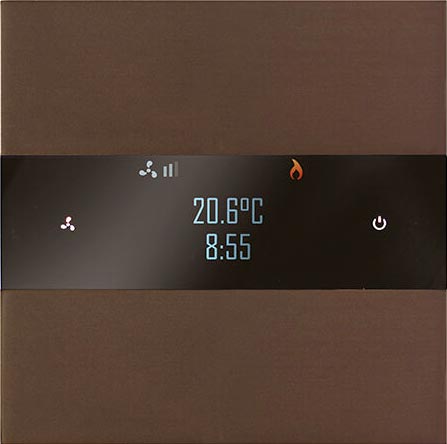
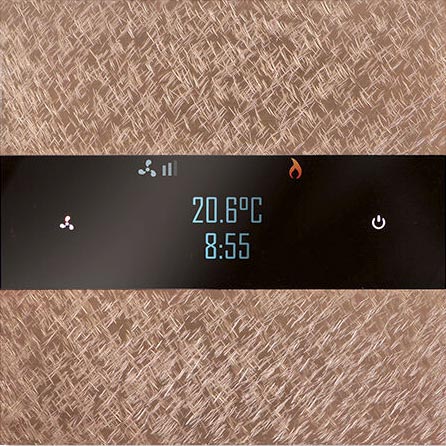
Basalte Sentido: quality meets design
The Basalte Sentido (available as a 2-way and 4-way button) with its elegant appearance, the highest level of workmanship and its variety of materials clearly belongs in the extremely high class of KNX push buttons. It comes from Belgium and is also manufactured there. In terms of price, the Sentido starts in the white satin version – of course made of aluminum – with four notes including German sales tax.
In the video “KNX push buttons for home control – material check” we present the Basalte KNX push buttons with their finest metal combinations for the right ambience.
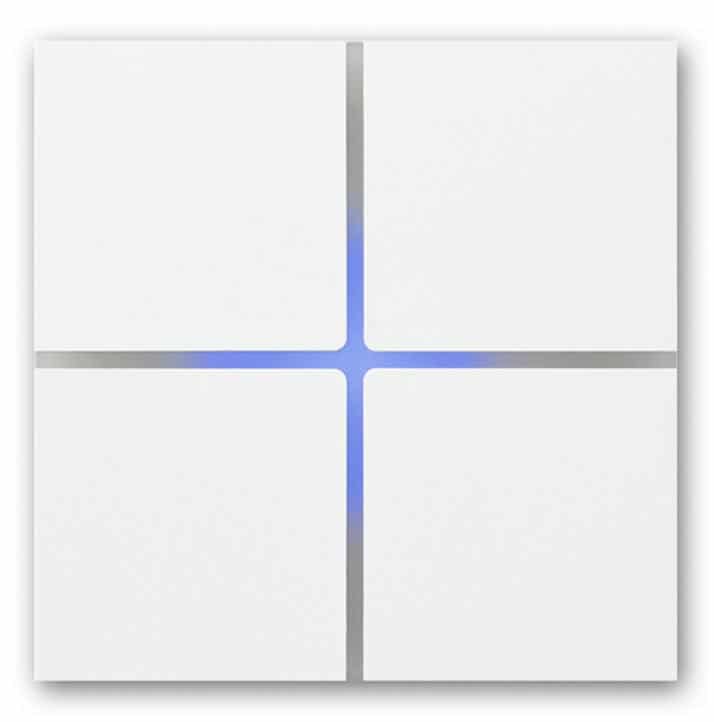
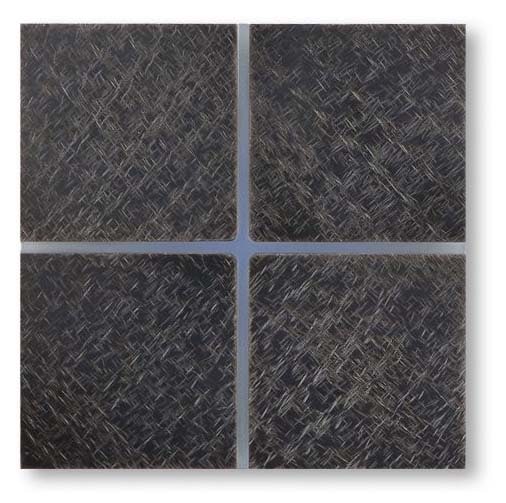
Quality and processing: more is not possible
In the entire market environment, the Basalte Sentido KNX push button is one of the best that money can buy. When mounted on the wall, the button is completely flush with the wall. The fitting tolerances here are as small as with any other KNX push button on the market. If that is not so important to you – please choose another candidate from our test field.
Features: Unique scene sequencer
The multi-touch function and the scene sequencer with LED pulser in the background are particularly noteworthy. Looks cool and good, no other KNX push button on the market has this shape.
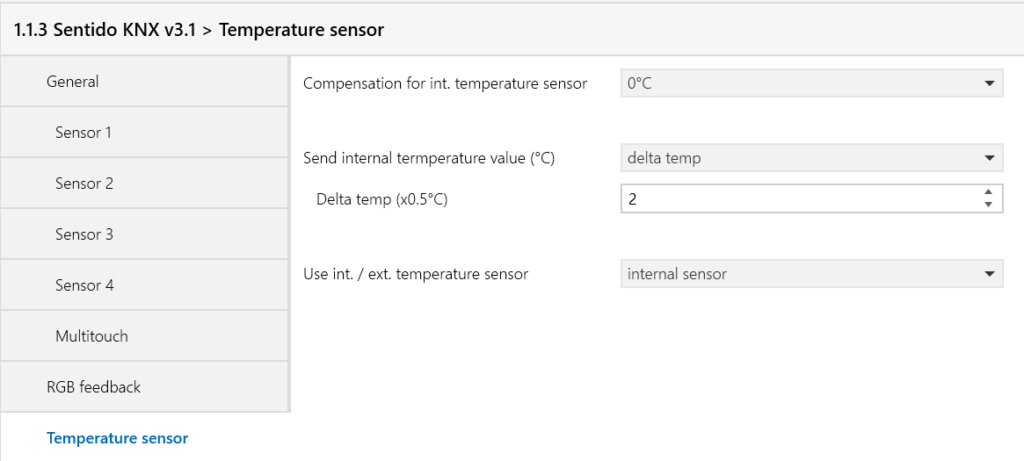
Target group: Upper class to luxury class
Anyone who is in the process of planning their high-end smart home based on KNX should definitely include the Basalte Sentido in their shortlist. The same goes for those who are just looking for a villa or a penthouse apartment – see also our post “What is a Smart Home Luxury Villa?” – implement. Since the Basalte Sentido could be intended for the next 20 to 30 years, it is a good investment in material and technology. And it looks really good – depending on the equipment for just under 400 euros a piece.
Basalte Fibonacci: Absolute luxury class
Compared to the Basalte Sentido, the Basalte Fibonacci is exactly 50 percent larger (in terms of surface area) and offers the same selection of functions and materials. The naming goes back to the mathematician Leonardo Fibonacci from the Middle Ages, who dealt with the “golden ratio” and aesthetic positioning.
The background: Basalte wants to use the name to appeal to architects in particular who have otherwise never heard of “smart home” or “KNX push button”. That also makes sense: because most architects still have no idea what a “smart home” and, what’s more, “KNX in house construction” could be. We have a lot of contact with architects, let’s hope for the best in this year 2023!
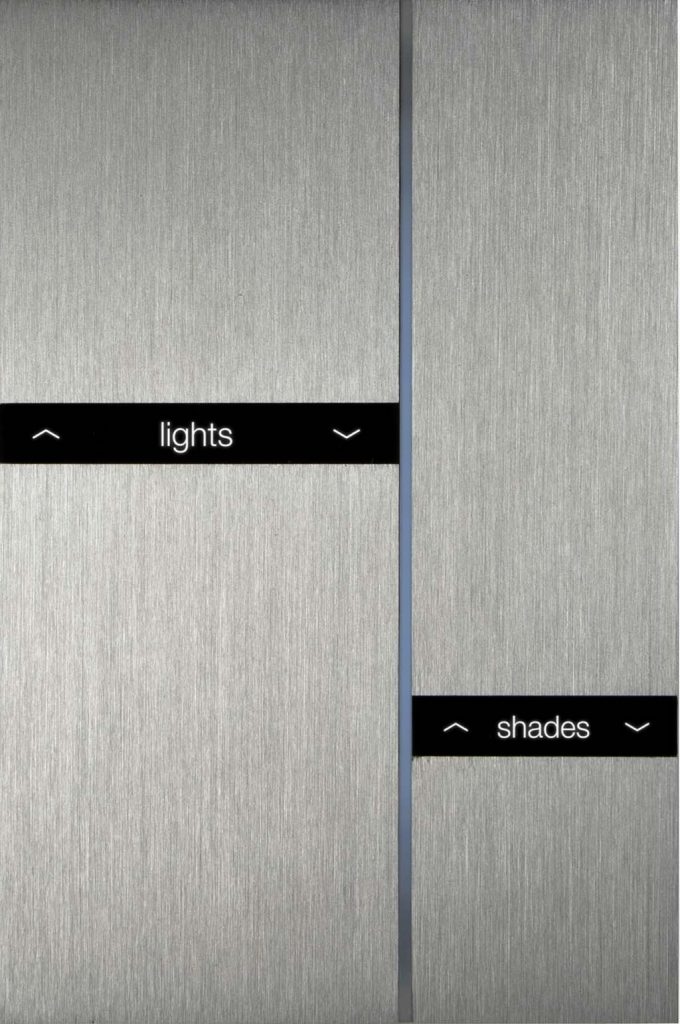
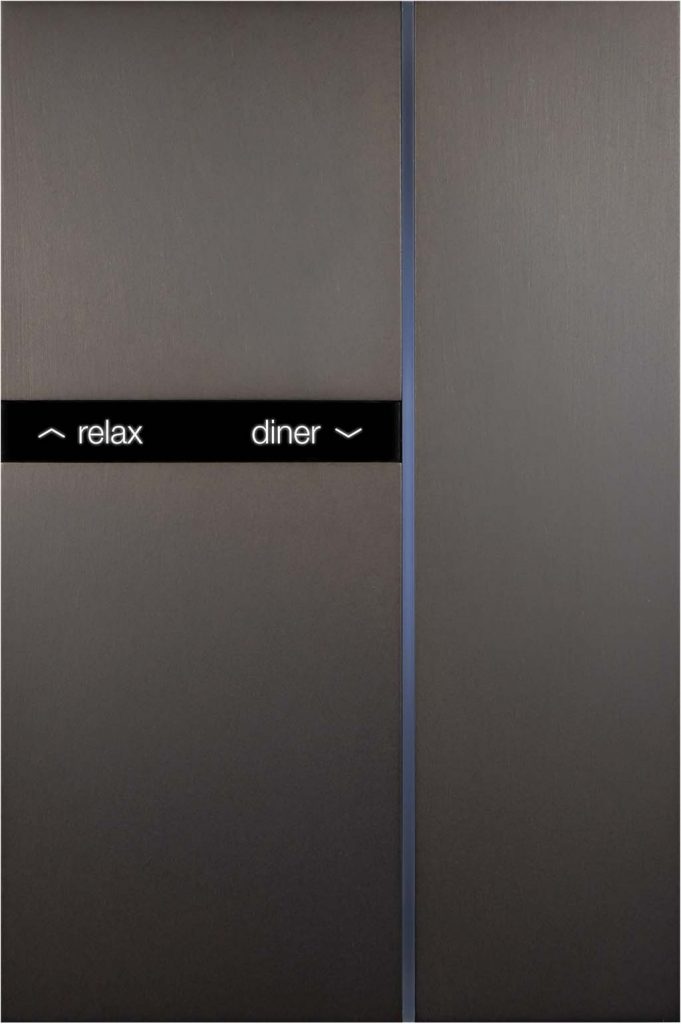
Quality and workmanship: Absolutely top
The Basalte Fibonacci KNX push button is manufactured in the same factory as the Basalte Sentido – in Belgium. The button is available in 12 different material versions and as a 2-way or 4-way KNX push button. If you can’t make up your mind, you can buy several surfaces over time and simply swap them out. Looks and feels good too.
Features: Very well equipped
As with the Basalte Sentido, the Basalte Fibonacci also has the multi-touch function and the scene sequencer with a pulsing LED in the background. That makes a lot, especially when invited guests are present. The highlight: the individually engraved switching functions, which are illuminated by LEDs.
The keys should only be assigned once and correctly. The room temperature can be measured and controlled via the integrated sensor – everything else happens in the actuator anyway. Oh yes, the Basalte Fibonacci has an integrated heating controller just in case, and it can also offer a cooling function (air conditioning).
Not to mention the cool proximity feature that automatically turns on the backlight so the Basalt Fibonacci can stay dark the rest of the time. At this point, the night light function should be mentioned, which can be set to 3 brightness levels and 10 different color tones.
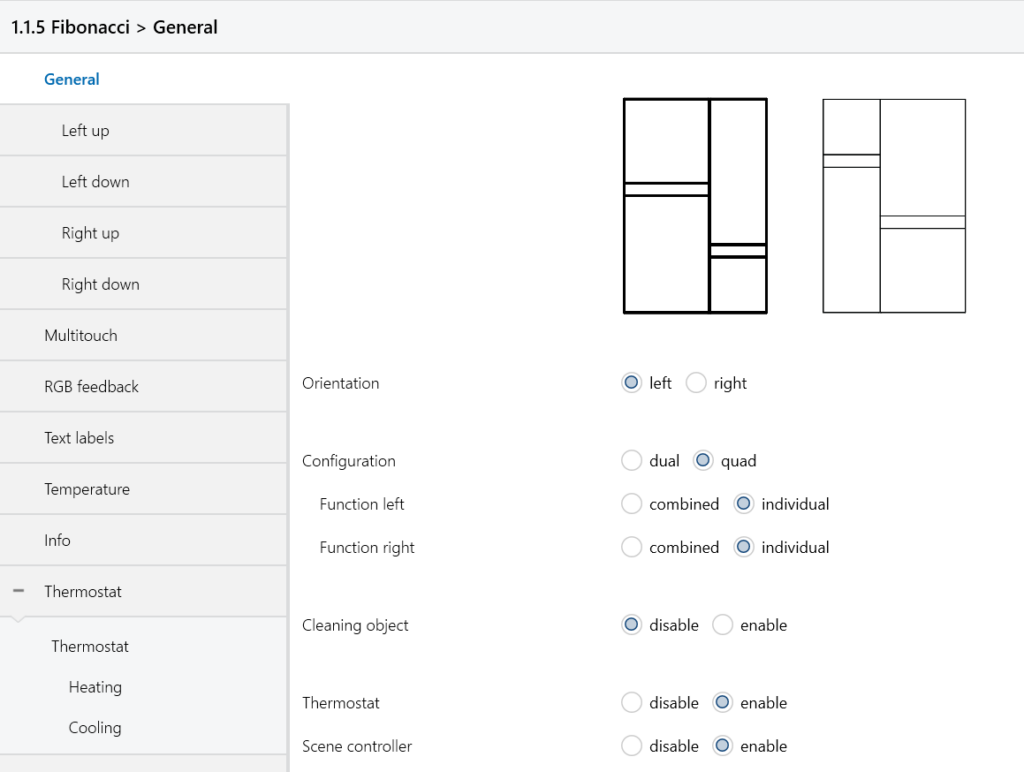
Target group: luxury class
The Basalte Fibonacci is clearly aimed at design-savvy luxury customers. These are executives from the upper middle class as well as successful self-employed up to top entrepreneurs. How does the object look like? This can be an old villa that has been given a new lease of life as a KNX smart home. Or it is an individual house construction for builders who really value the highest processing quality and material appeal.
At least 550 euros are due for the basalt Fibonacci, which in any case can be seen and felt by the residents or guests. It’s like getting into a current Mercedes S-Class. Depending on the material variant selected – there are 12 to choose from – the Basalte Fibonacci costs a few euros more.
Gira Tastsensor 4 Komfort: Really good KNX push button
Compared to its predecessor – the outdated Gira Tastsensor 3 – the brand new Gira Tastsensor 4 is real worlds apart. Everything is new and looks much more elegant: The stainless steel version makes its way into the upper class of KNX push buttons and really convinced us. The right sensors are also on board and save on the budget and additional wall outlets for each room. With the new KNX push button, Gira is really looking into the future and has invested a lot of time in the development of hardware and software. Class!
We have published a detailed test of the Gira Tastsensor 4 Komfort in the article “Test: Gira Tastsensor 4 Komfort – best KNX push button in the segment? LEDs & humidity sensor”.
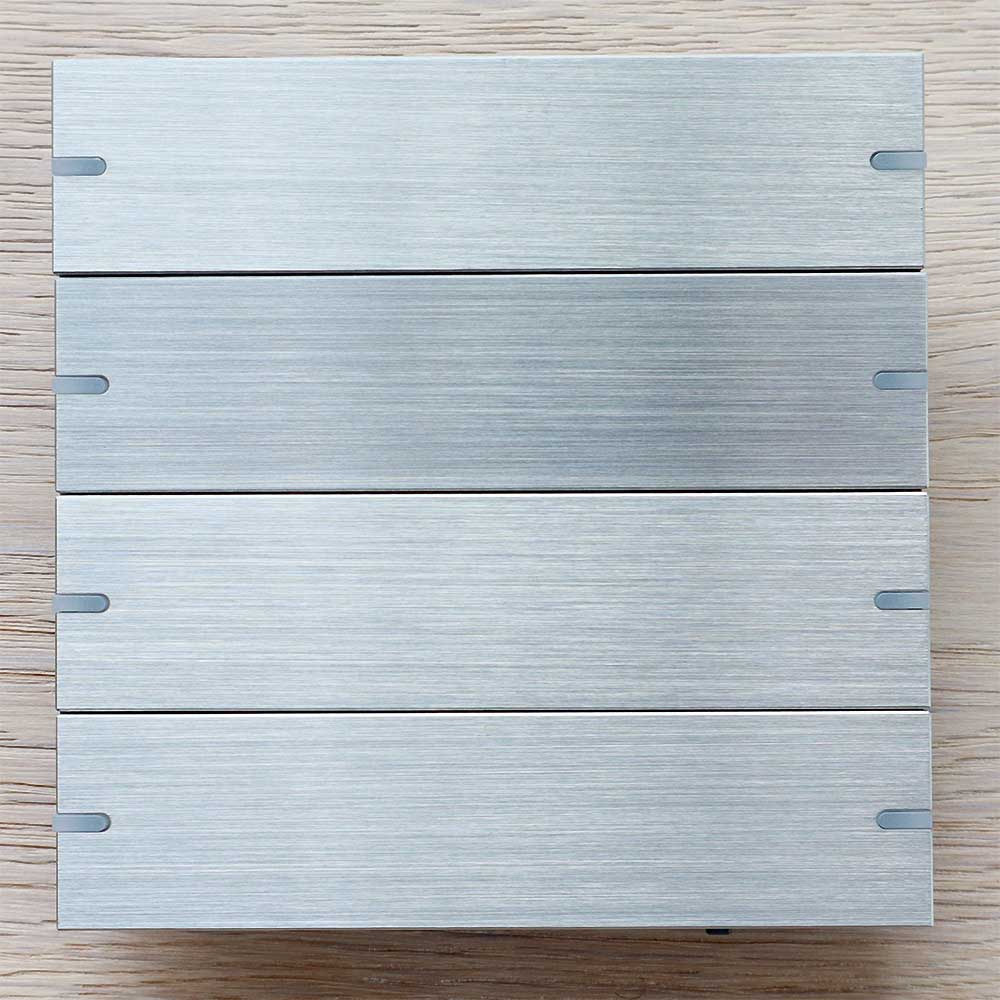
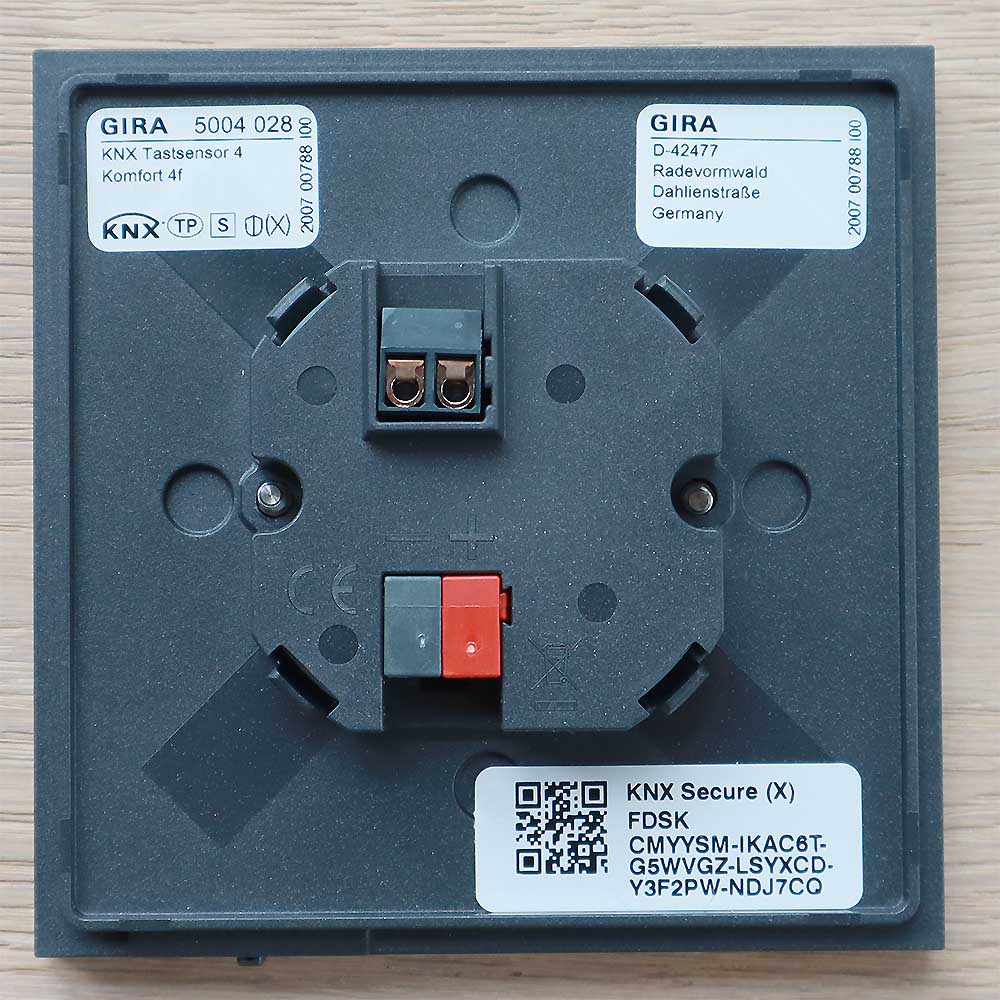
Quality and workmanship: very good
At first glance, the processing and quality impression is very good, at second glance the very good and harmoniously lit LEDs for status display are noticeable. That looks even better than with the Berker B.IQ, here Gira in Radevormwald seems to have analyzed the market in detail. It could even be that the developers analyzed the high-end competition in detail and got some suggestions. Direct hit!
Features: Everything you need
The quality (and color rendering) of the colored status LEDs of the Gira push button sensor 4 Comfort, which can also be used as night light LEDs, is unique on the market of all KNX buttons. There are scenes in the button that can be called up or changed. Highlights are the integrated sensors for measuring the room temperature and room humidity – the latter in turn saves additional KNX components and drilling work in the wall.
The Gira push button sensor 4 comfort can be configured as an 8-way single button or as a 4-way rocker (highly recommended). If you want to control fewer functions in the room: the push button sensor 4 is also available as a double version. Also an absolute eye-catcher!
Depending on the equipment, the Gira pushbutton sensor 4 costs between 180 euros and 330 euros.
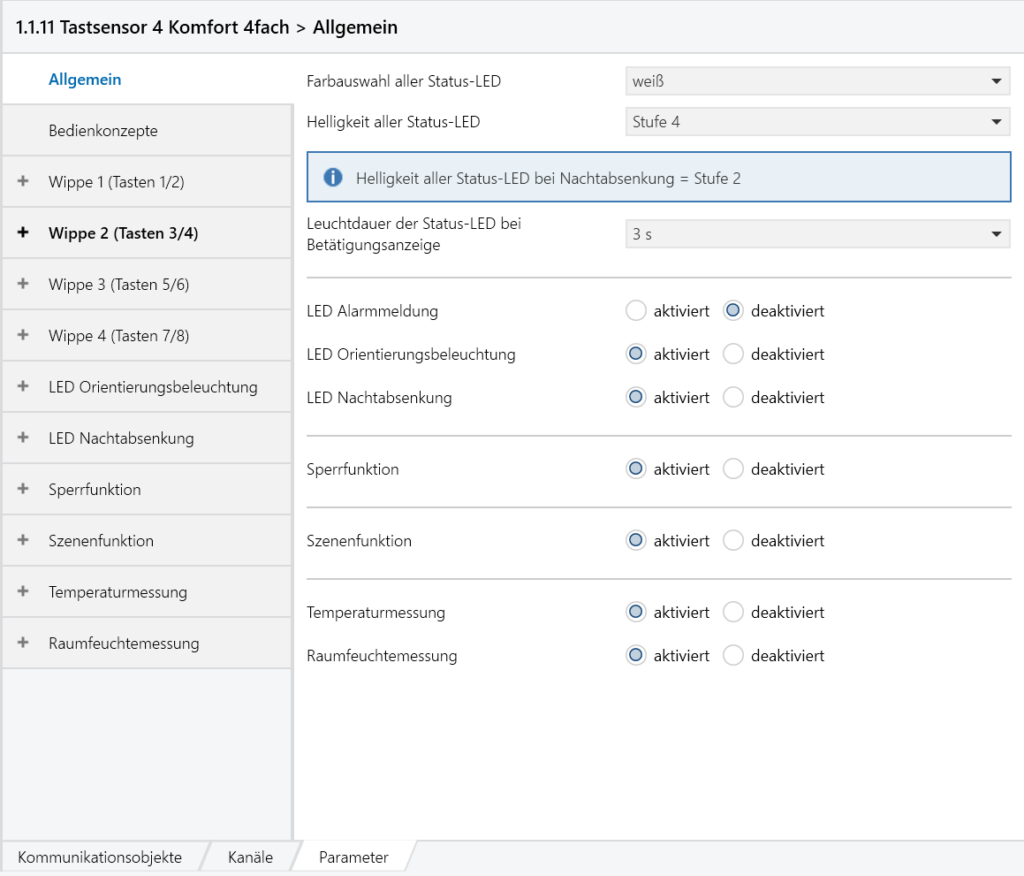
Target group: Upper middle class
New build customers with regard to Smart Home, who want a KNX button that, in addition to good workmanship, attractive LED status lights and a wide range of functions, convinces with a very good price/performance ratio. The Gira push button sensor 4 comfort in the stainless steel version is not a bargain, and with this equipment it does not want to be and cannot be. If you want it really classy, you can also have the key functions engraved.
The stainless steel comfort version (top model) shown and tested by us comes to a good 330 euros and is slowly moving closer to the Basalte. This is certainly what Gira intended.
Berker B.IQ touch sensor: Noble evergreen
The German company Berker, based in Schalksmühle, made a good name for itself very early on for high-quality workmanship and, above all, very good design with KNX buttons. The development of the Berker B.IQ pushbutton sensor KNX dates back to the mid-2000s, more precisely to the year 2005. Then as now, the noble KNX push button or KNX switch convinces with its material appearance and highest processing quality. Low fitting tolerances were already a big issue back then, which is by no means a matter of course for all manufacturers today.
In the course of the takeover of Berker by the much larger company Hager (2010), innovations in the KNX area are no longer as much in focus as in the past – one might think.
We also show the Berker B.IQ as a KNX push button in the article comparing the “Top 10 push buttons & touchscreens for KNX home control”.
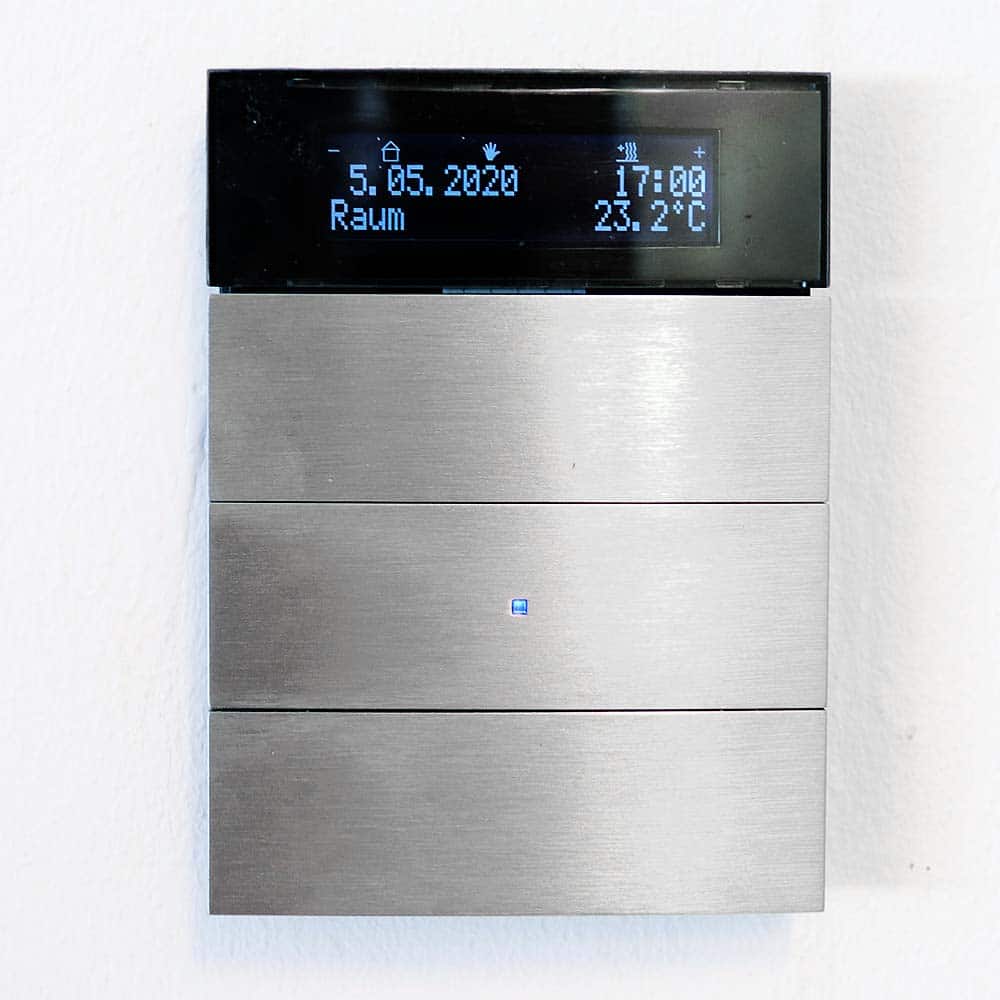
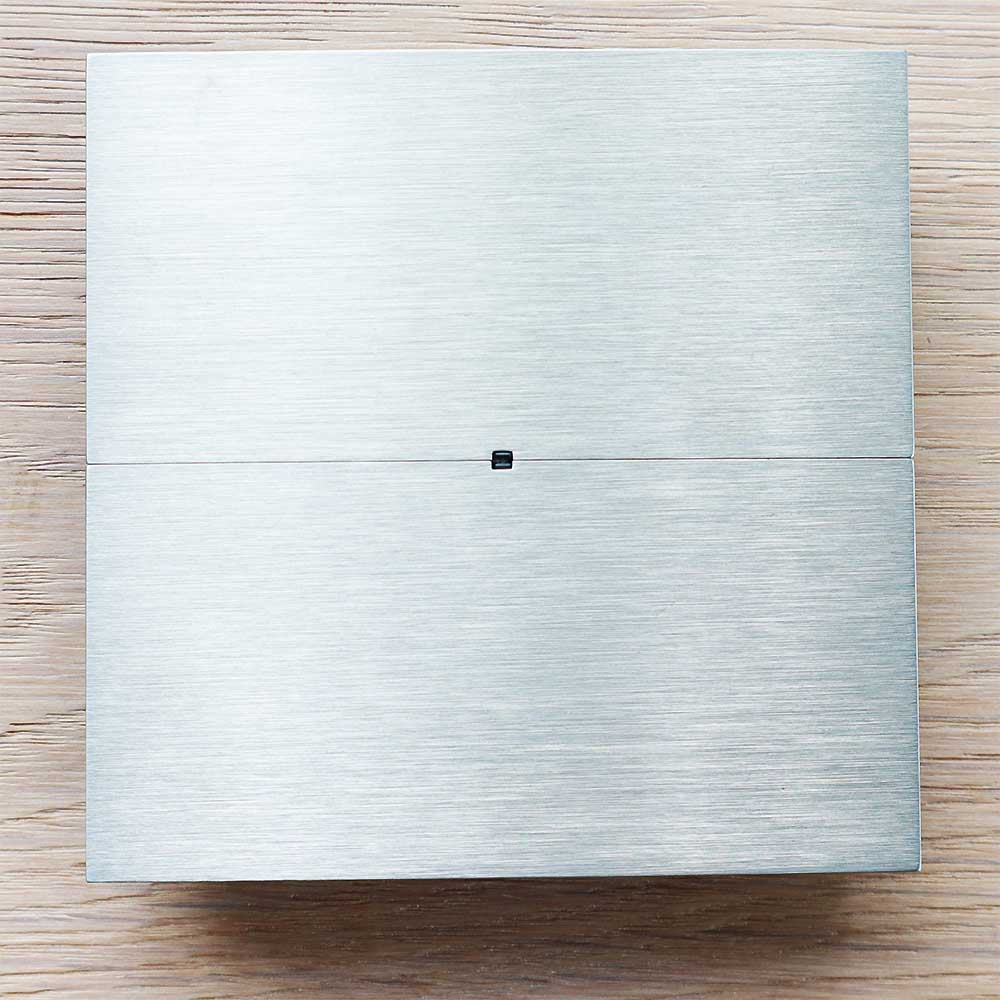
Quality and processing: Simply top for decades!
Very good workmanship, also considering the really heavy stainless steel rockers, which have kept their low fitting tolerances even after many years (>15). Scratch-resistant with a clean click feeling and perfect surface feel, the Berker B.IQ pushbutton sensor KNX can last for decades. No joke! We have experienced it!
Functions: It also works without a display
The variant of the Berker B.IQ push button sensor 3-fold with integrated room temperature controller and display comes up with its own scene module. Everyone has to decide for themselves whether the integrated display is still up-to-date or not. The blue glowing KNX bus LED in the middle of every Berker B.IQ still looks really cool.
Then as now, the white glowing status LEDs are an eye-catcher – could Gira have found some inspiration here for its brand new push button sensor 4?
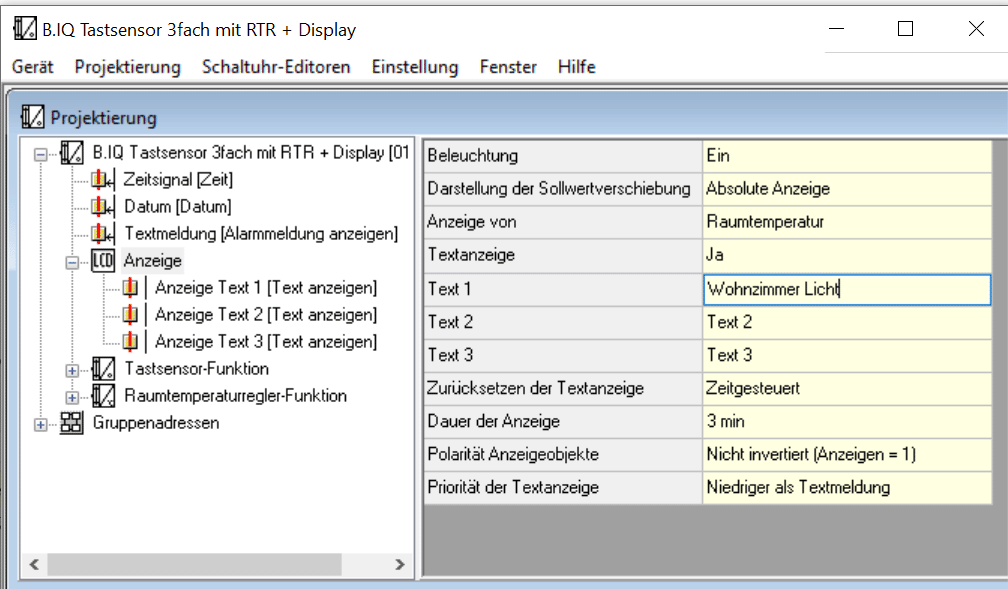
Target group: Upper class with an affinity for design
If you buy a classy KNX Smart Home (see also Smart Home Villa) in stock, you could come across the Berker B.IQ in the stainless steel version. It can still be retrofitted today. It is very well suited for both new construction and renovation. For the long time that the Berker has been on the market, it is a real bargain today: the triple stainless steel version of the Berker B.IQ with a display costs just under 270 euros, without a display it is only 150 euros. The range of functions may be less.
Berker Series 1930 R.classic: Conversion to a KNX push button
Actually, the Berker Series 1930 R.classic is a very ordinary rotary switch for conventional electrical installations that no longer fits in with our times. Since it is often requested by design-savvy builders and above all architects for furnishing old Art Nouveau villas, a solution had to be found for integration into the KNX system. And there is!
Of course, it didn’t come from Berker itself (now part of Hager) but is designed and implemented by people like us. The Berker Series 1930 switch is available as a “rotary switch with two different outputs and zero position”, which can be “converted” to a simple KNX button via a connected KNX button interface. For example, a villa from the 1900s can be completely equipped with a KNX system including the 1930s look of the Berker S1930.
It remains incomprehensible to all of us why Berker does not finally build its own KNX button with the continuing sales success of the 1930 series. The appropriate KNX button interface is best taken from Theben, which is easiest to configure in the ETS 5/6.
And what about the costs? For just under 200 euros, the builder receives a good optical integration of the retro button with KNX connection – without a temperature sensor and extensive functions, as offered by the other KNX buttons in this area.
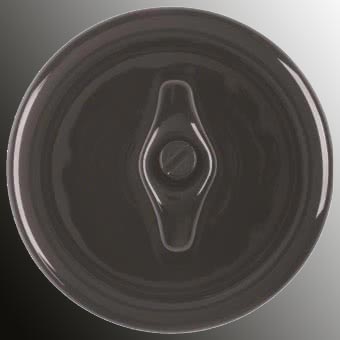
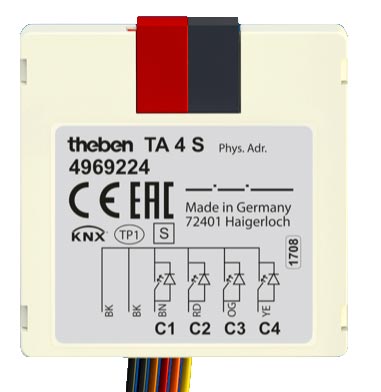
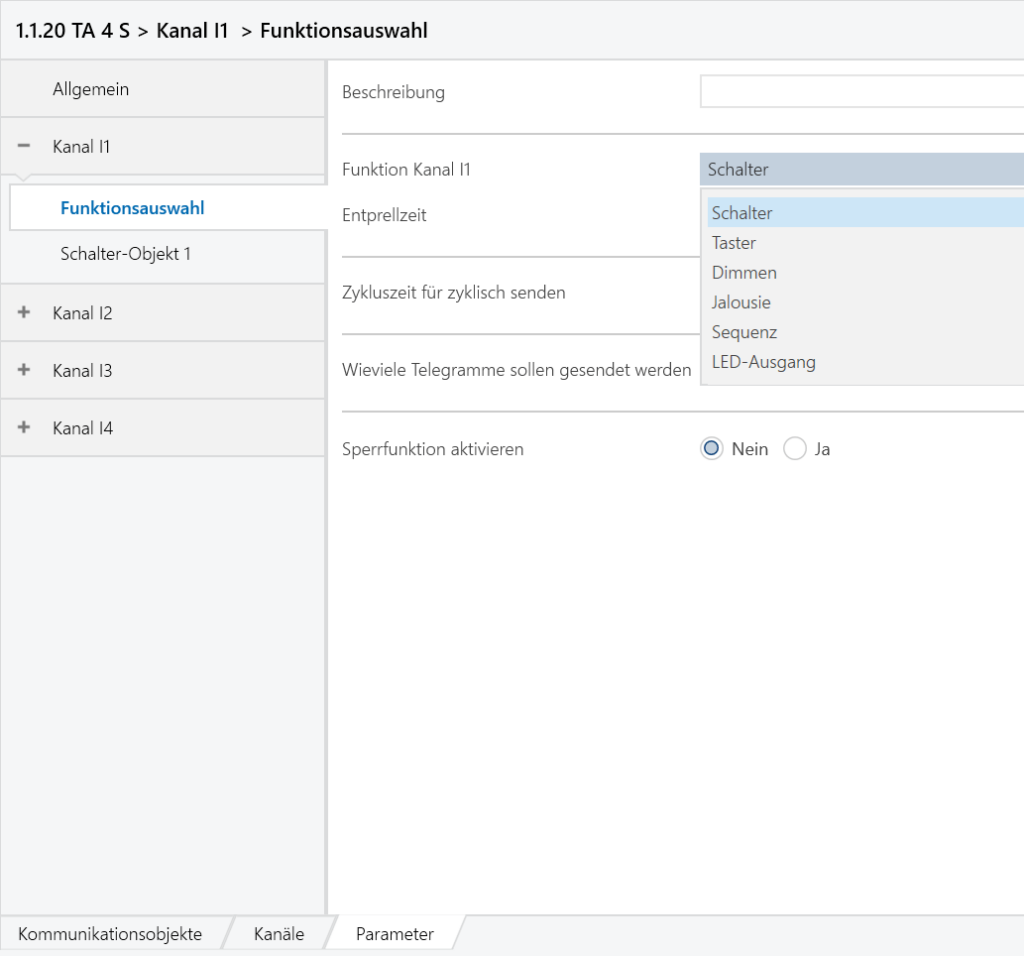
Enertex MeTa KNX Premium: Mega equipment
A large black KNX push button with display and rockers made of brushed aluminum – in our version in black. This is the Enertex MeTa KNX Premium, where “MeTa” stands for an additional “menu button” in the name, which no other provider on the market has to offer.
Enertex is a German company based in Forchheim, Bavaria. The KNX push button comes in three versions: Starter, which is more of a budget version, Standard, which is the better of the two, and the Premium version, which we would recommend.
We have published a detailed test of the Enertex MeTa KNX Premium in the article “Comparison of top KNX buttons: Enertex MeTa Premium vs. Standard”.
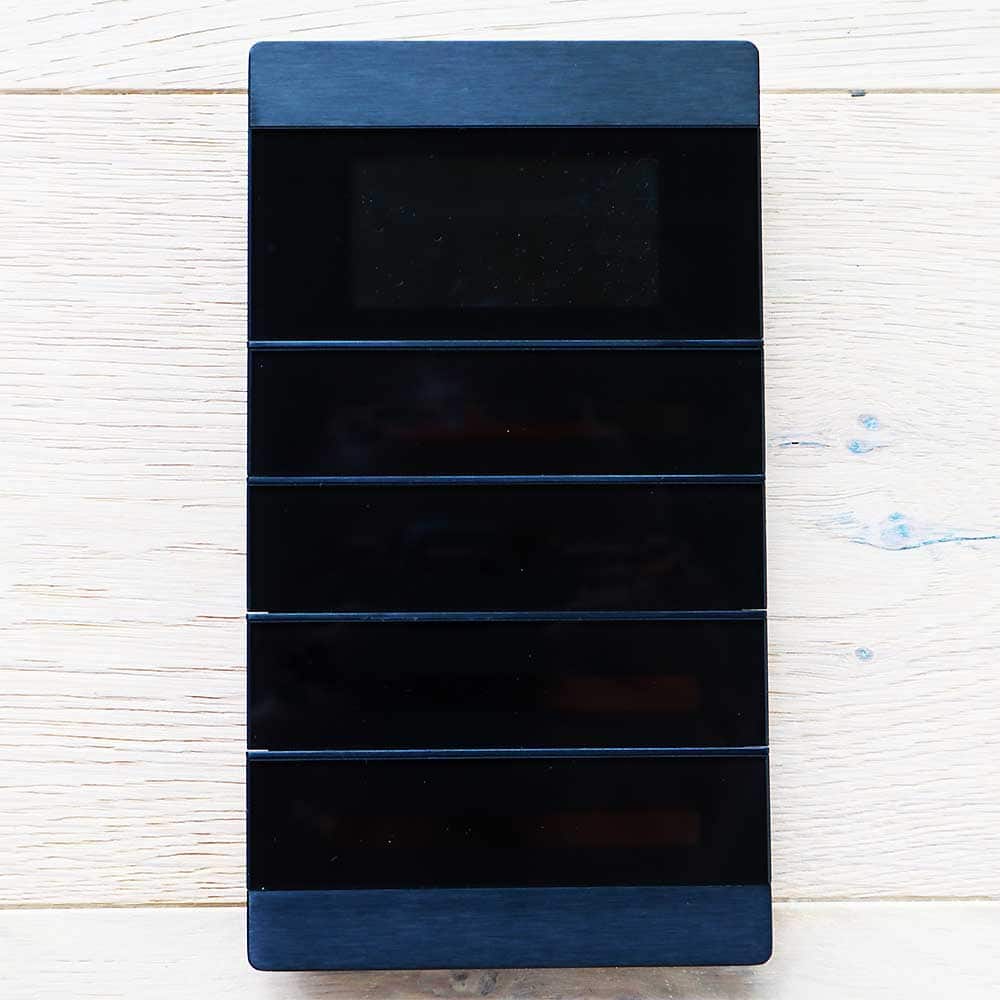
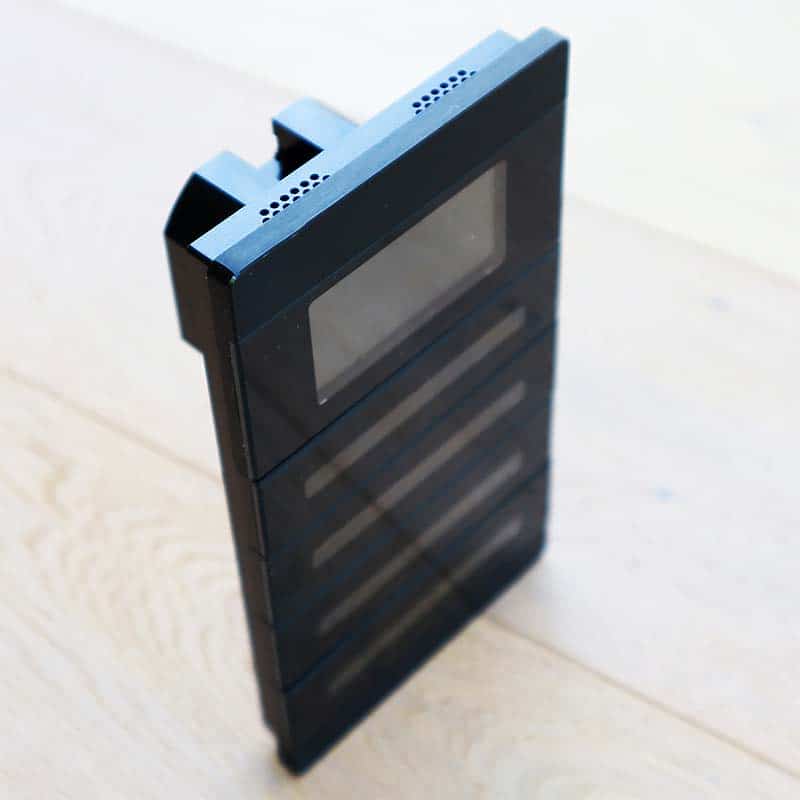
Quality and workmanship: very good
All versions of the Enertex MeTa KNX button are very well made and differ in the number of buttons, the choice of material and the range of functions. We like the black premium version made of brushed aluminum and the big hit: the real gold version on a brass basis, which also cuts a fine figure in German houses.
Features: None offers more
Based on the Enertex MeTa KNX Premium, there are many functions in a single push button: It starts with the heating controller, goes through the integrated sensors for light brightness, humidity, room temperature to the binary input. The latter can be used, for example, to query window contacts for an alarm function.
The real highlight of the Enertex MeTa KNX Premium: All rockers/buttons can be labeled electronically in the KNX ETS5/6 software. The music titles of a multiboom audio system could also be displayed on the Enertex MeTa via the KNX bus.
In addition to showing the button assignments, there is a large display above the rockers that shows the ventilation system status, room temperature, etc.
Of course, this range of functions also includes definable scenes. Whether you need them in combination with a modern KNX visualization server must be decided individually.
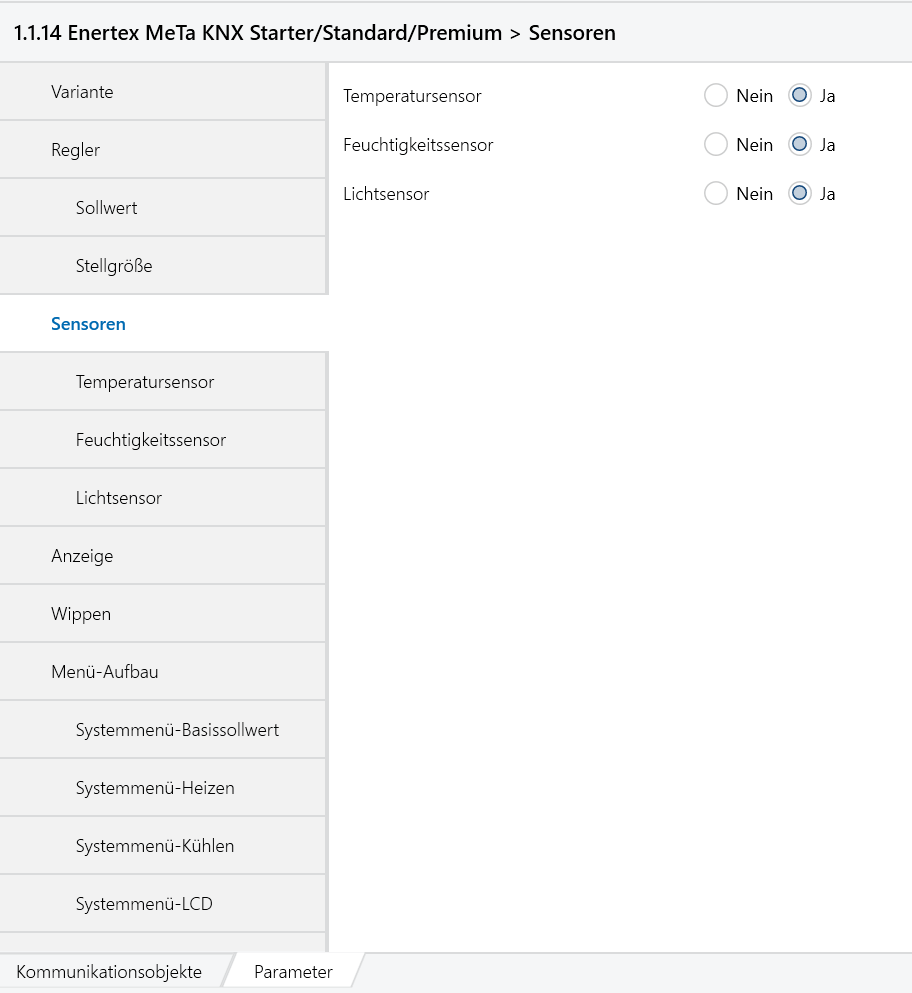
Target group: Upper class with a luxury tendency
Enertex is something for special customers who like something special and yet don’t want to spend a fortune. Nevertheless, the price scale extends almost to the highest segment (where Basalte is located) for the real gold version of the Enertex MeTa KNX Premium. A little more than six notes including German sales tax have to be invested here. Nevertheless, the MeTa in the premium version is clearly one of the upper class among the KNX buttons and really looks good – for just under 450 euros. The unique real gold version costs 650 euros and has long since found its way into suburban villas in Germany and Switzerland.
There is also a cheaper way: The Enertex MeTa Standard, which we also tested and use, is available for just under 300 euros.
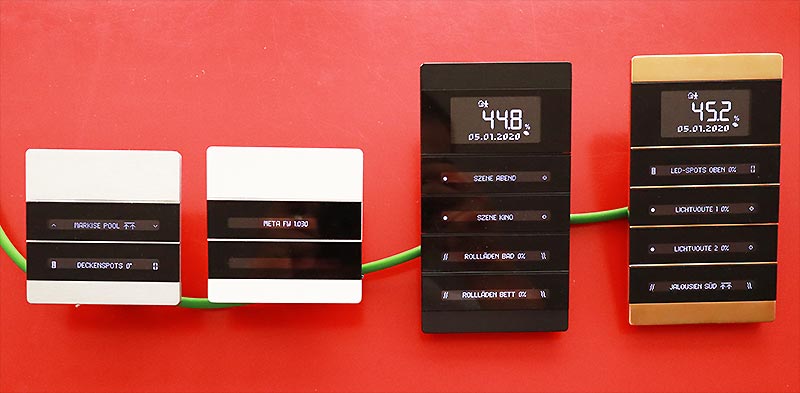
Jung F40 tactile sensor: Minimalist and inexpensive
The German company Jung is one of the pioneers in the field of KNX buttons and KNX bus systems in general. The F40 push button sensor (really has nothing to do with Ferrari’s super sports car, the F40) is available for a wide variety of frame variants and switch designs – primarily made of plastic. If you want it really chic, you can use the LS series and then the LS990 colors of Le Corbusier. It costs a lot more, but it also looks really good.
From our point of view, the LS series with its narrow frame is best suited for use in a modern new Smart Home building, although, as with most KNX buttons, it is always a question of personal taste and the design of the room/object. The LS series can be combined with different frame colors and materials (also made of metal), so that the result is a real eye-catcher on the wall – if desired at all.
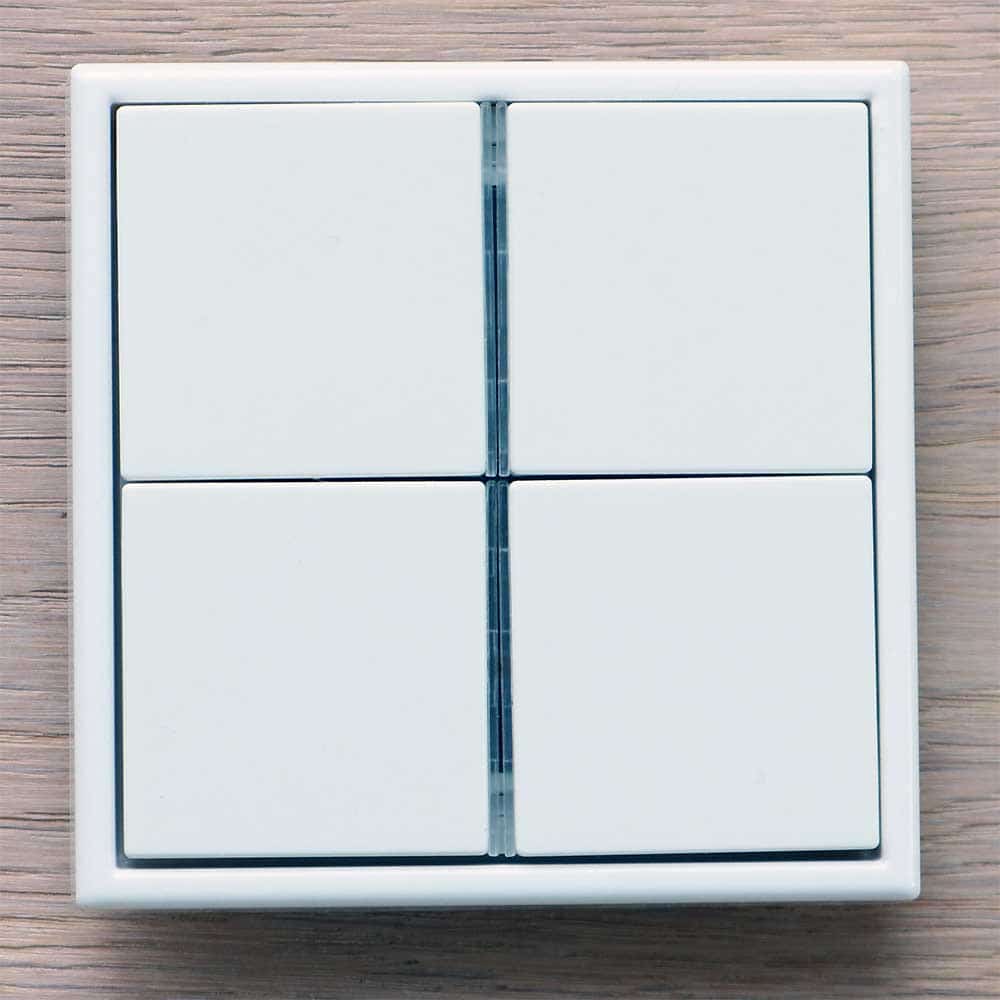
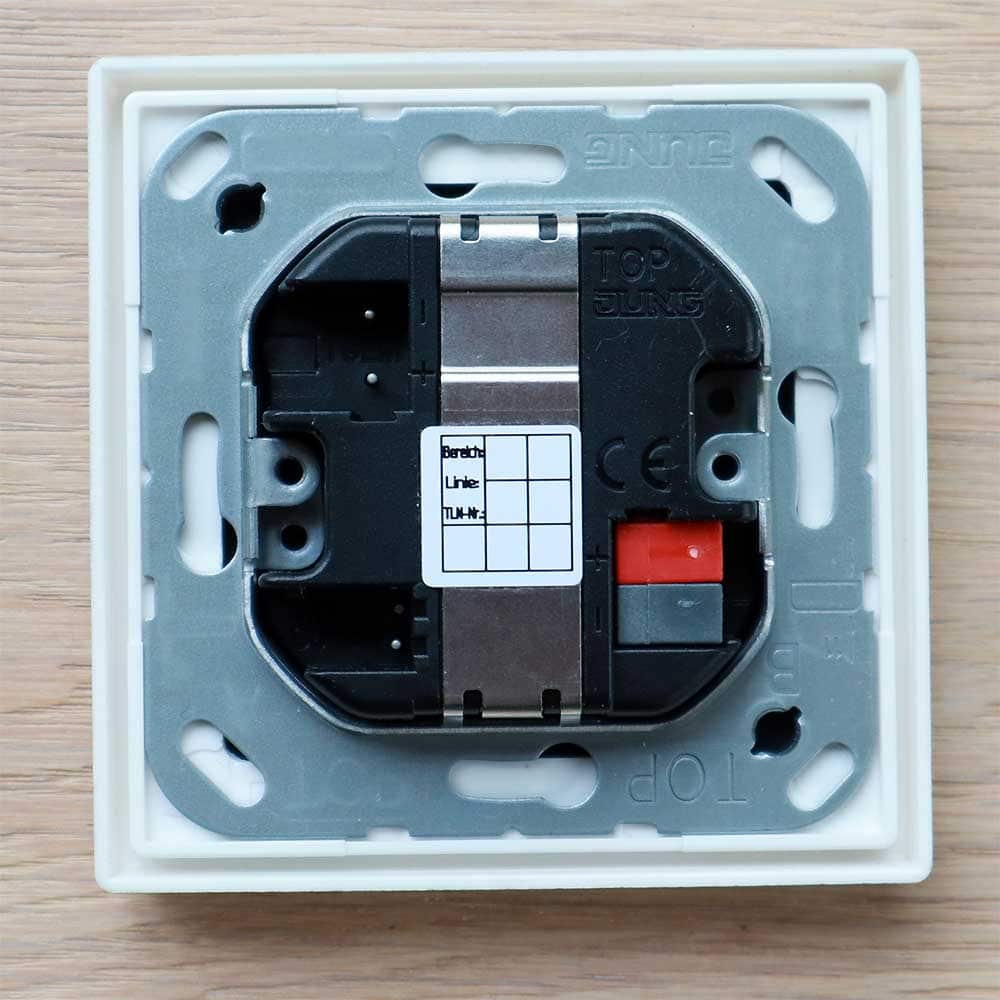
Quality and workmanship: Good
Compared to the significantly more expensive KNX push buttons with solid metal buttons and surfaces, it is in the nature of things that plastic buttons have a different click feel and therefore do not come across as high-quality. If you start nagging here, you have to dig deeper into your pockets. The bottom line is that the workmanship can be described as good and the keys should be very “easy to care for” over many years.
Functions: Solid basic equipment
Each Jung F40 KNX push button has an integrated sensor for measuring the room temperature. The buttons can also be labeled, so there are many customization options. A status LED can also be configured for switching functions.
Target group: Larger apartment buildings
The Jung F40 Tastsensor is on the agenda when a property developer sells the same number of residential units in the upper segment and as “smart homes”. Then many push buttons can be installed in apartments and rooms at favorable conditions – at well under 100 euros per piece. Incidentally, electricians also like to do this when it comes to larger project business.
Jung F50 Tastsensor: Great variety
The Jung F50 tactile sensor differs from the Jung F40 in the different button arrangement and the optional display in the middle. Anyone who needs a status display and is in the Jung design line could be well advised with the Jung F50.
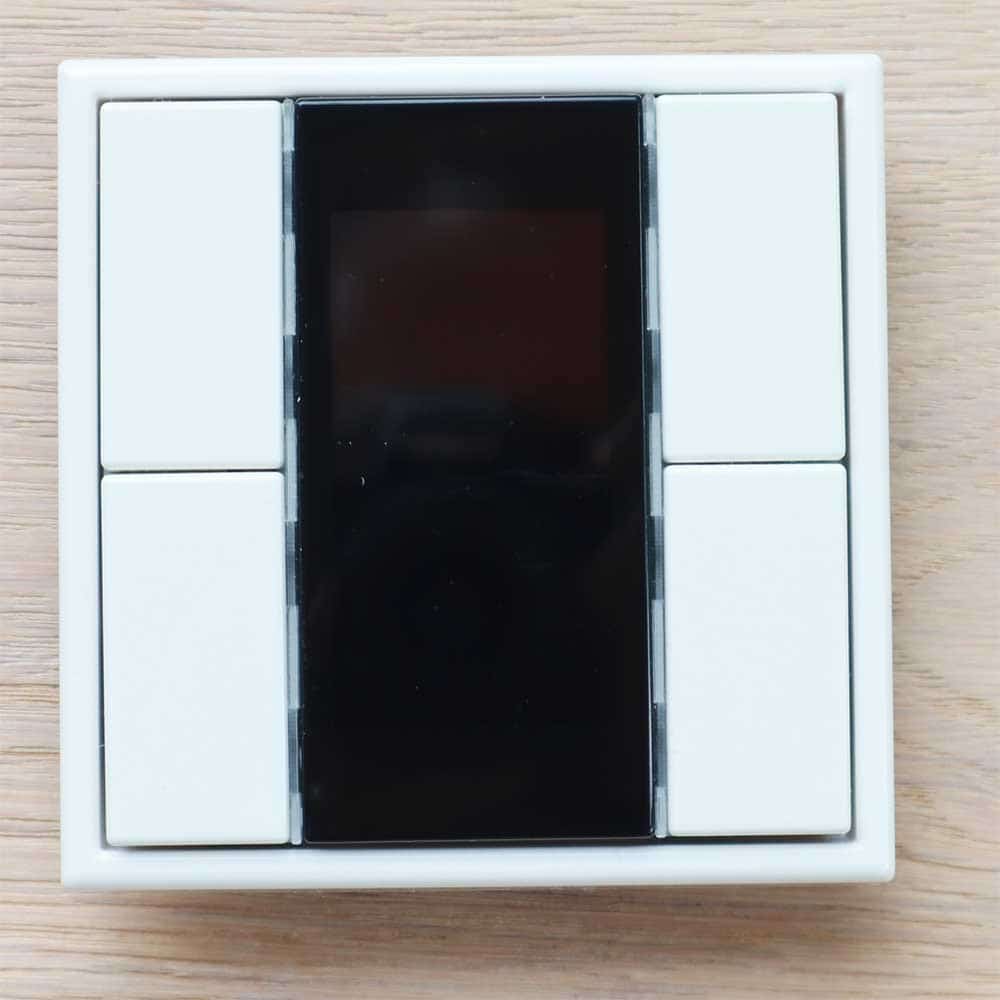
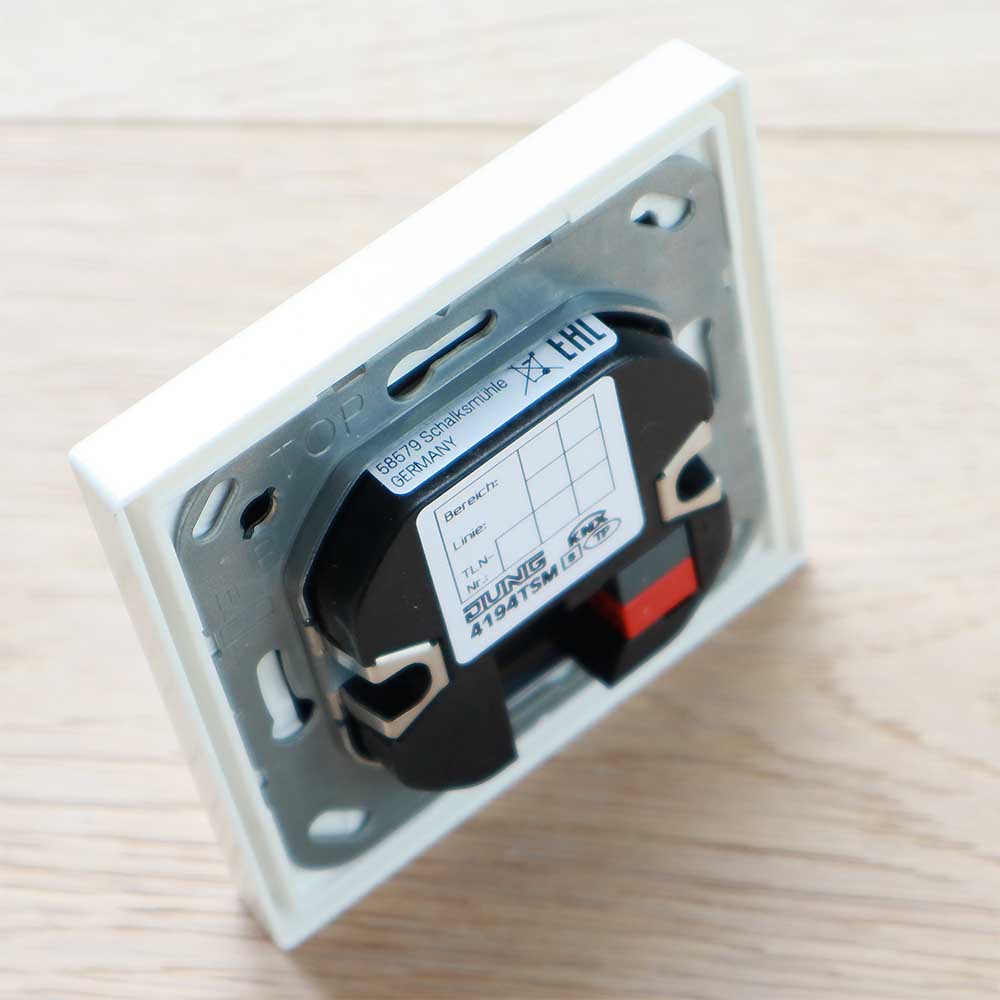
Jung LS Touch: Hot newcomer 2023
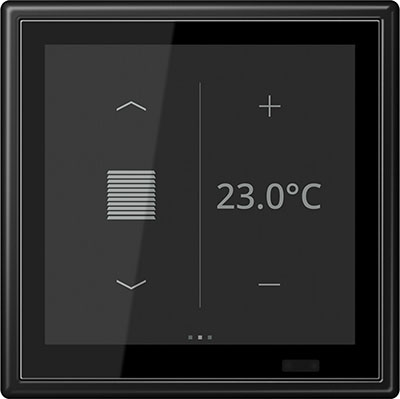
The Jung LS Touch was just presented at the Light & Building trade fair in Frankfurt at the end of 2022 and at first glance looks like a more elegant version of the MDT Glastaster II smart. Jung probably oriented himself to the competitor in the development and design. In terms of price, the Jung LS Touch positions itself in the luxury league above 450 euros. This is of course an announcement! We will examine and present the Jung LS Touch in more detail in a few days.
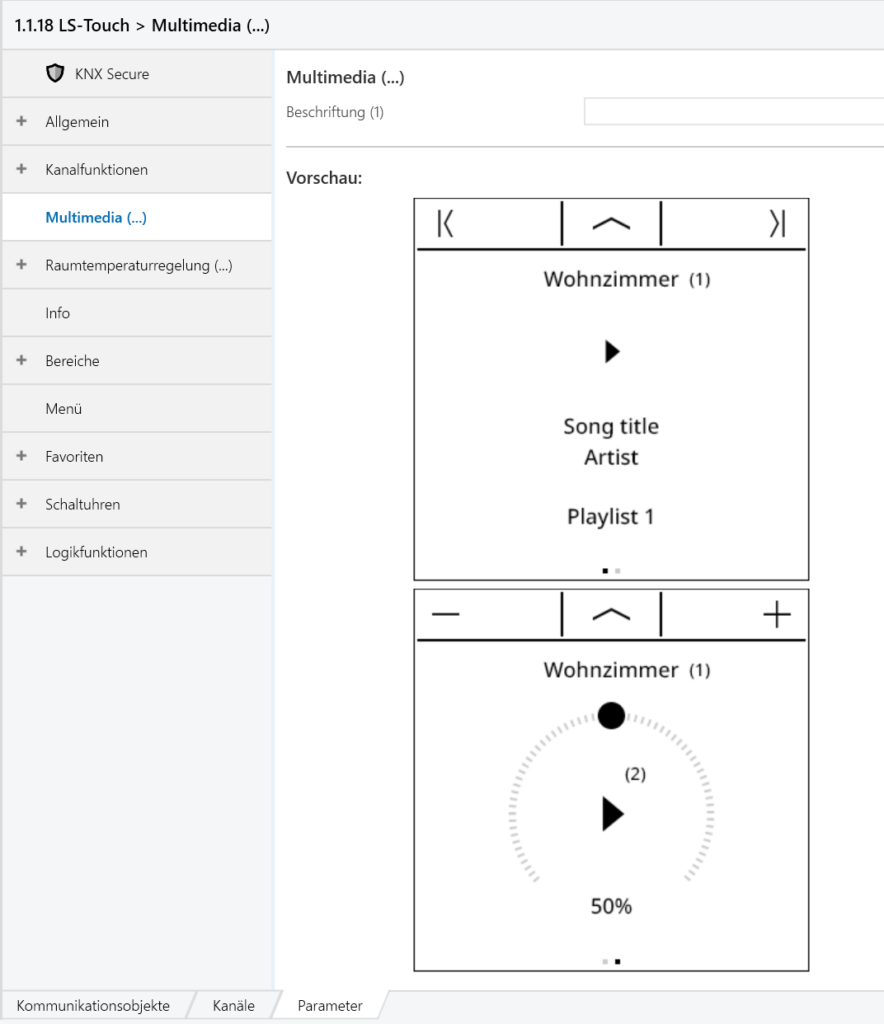
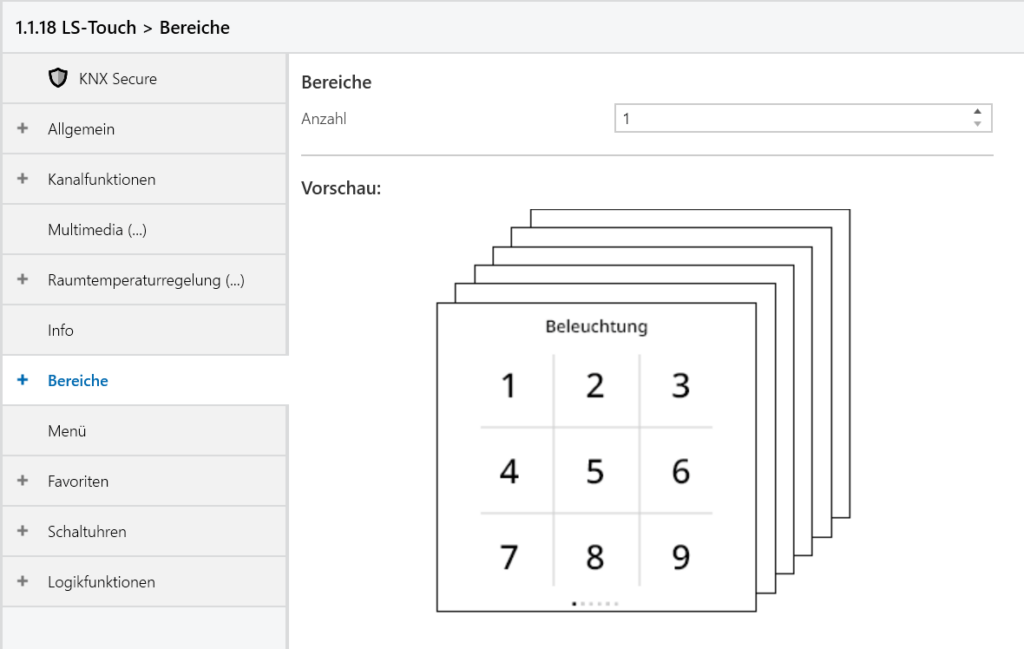
MDT Glastaster II smart: It doesn't get any cheaper
And here comes a bang that has it all: The German company MDT is mainly responsible for the strong price decline of up to 30 percent for KNX actuators and KNX push buttons in the entire market over the past 8 years. No joke! The company has attacked the established competition with Berker, Busch-Jaeger, Gira, Jung and Siemens at full throttle. For cost reasons, many builders, especially private family house builders, rely almost exclusively on KNX actuators from MDT in the control cabinet. This makes some electricians who have previously bought and installed the competitor push button wholesalers flush with anger. The next 10 years will show whether this decision was the right one.
MDT also has some real bargains on offer for KNX push buttons, where the competition can only keep up to a small extent or not at all. One of the most popular and best-selling KNX push buttons is the MDT Glastaster II smart, which has been available in “black” for some time in addition to the classic white version. Thus, the MDT Glastaster II smart can certainly be regarded as the “VW Golf among the KNX push buttons”.
MDT has been offering the Glastaster since 2014, which was expanded in 2016 to become the Glastaster II smart. If you still know the company from earlier days: MDT offered inexpensive memory modules for Windows PCs in the early 2000s.
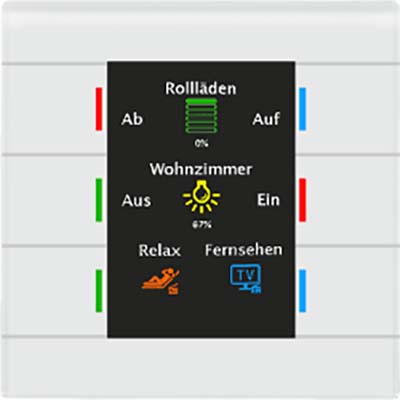
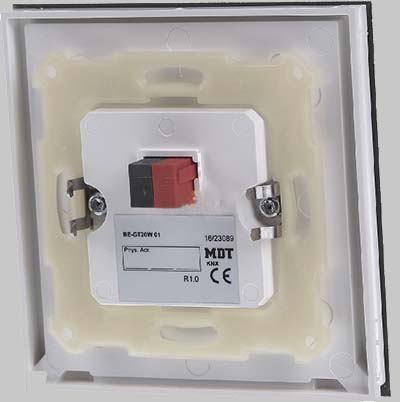
Quality and workmanship: Good
To make it clear right away: the MDT Glastaster II smart is well made despite its low price. It should come as no surprise that, considering the price range, no top performances can be expected as in the top-of-the-line KNX push button class. The MDT KNX push button reacts to touch (capacitive) and has an integrated backlit LCD display. The design of the icons can be customized and the labeling is flexible for all buttons and functions. You can certainly argue about taste.
What is noticeable with some MDT Glastaster after mounting them on the wall: They can be twisted a little too easily and may therefore hang a little crookedly. However, it is only noticeable if you look very closely.
Functions: Very good basic equipment
No manufacturer offers more functions in this price range: the Glastaster, which should actually be called a “acrylic glass” button (from the look and feel) is an extremely good choice for technology lovers and non-design fans. In the upscale family houses in the suburbs, the Glastaster II smart will only make it down to the basement, because it is usually the woman who decides when to buy the KNX switch or KNX push button.
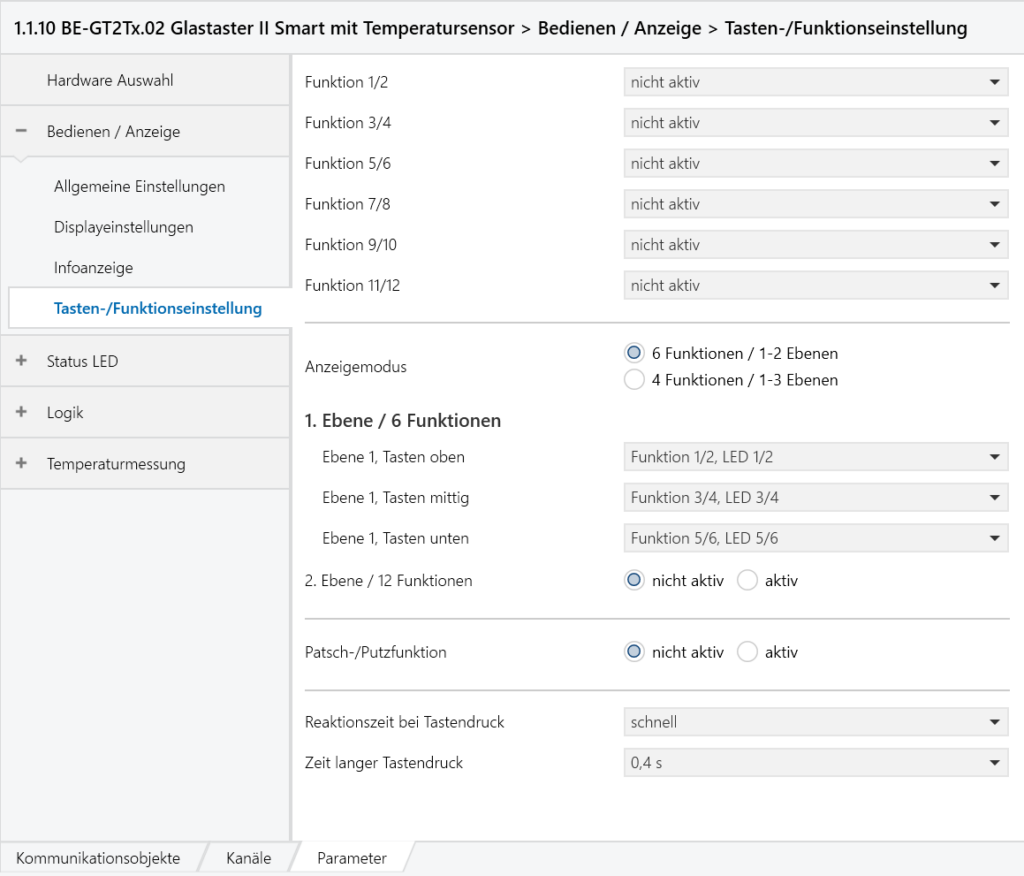
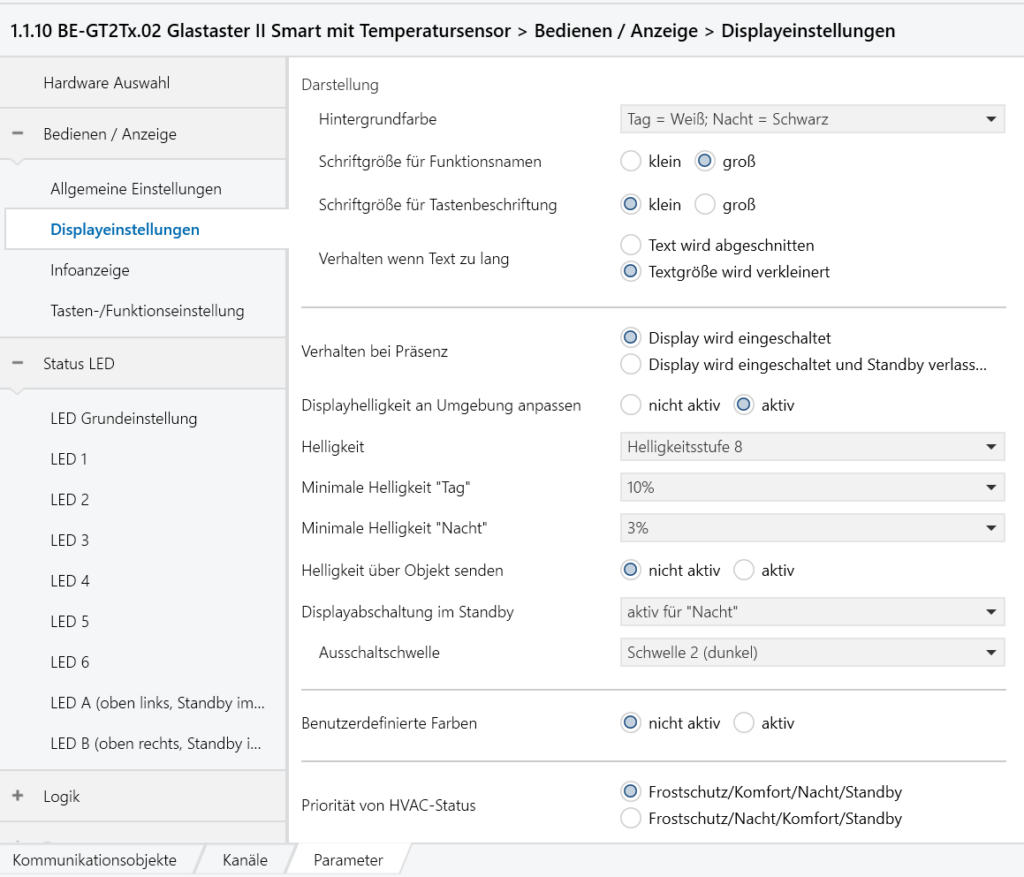
Target group: KNX beginners without great design requirements
No other manufacturer is able to offer such a well-equipped KNX push button product with a display for just over 140 euros. Weaknesses can be seen in the material quality, the visual appearance and the graphic design of the icons on the display. If you have calculated your smart home with KNX very tightly, you should urgently use the MDT Glastaster II smart or the even cheaper MDT Glastaster II light – in the whole house.
The MDT Glastaster II has enabled many builders in the middle segment to consistently rely on the KNX system and to take the right path when building a new house. Well done MDT!
In terms of (software) technology, the Glastaster II smart (since 2016) is state-of-the-art and the variety of functions far exceeds what you are used to from this price segment. Since 2019, the Glastaster II smart has also been available in a black version.
Enertex ProxyTouch: Invisible KNX push button
Enertex is a Bavarian-Franconian company specializing in the development and manufacture of high-quality KNX components. The Enertex ProxyTouch has a unique position in the global market for KNX push buttons: It is the only KNX push button that can be placed behind walls such as tiles or drywall and reacts to hand swipe gestures. Swipe gestures in the KNX environment? That’s right, even on a smooth (shower) wall with or without tiles.
We published a detailed test of the Enertex ProxyTouch in the article “KNX push button completely invisible: Enertex ProxyTouch – button behind the wall”.
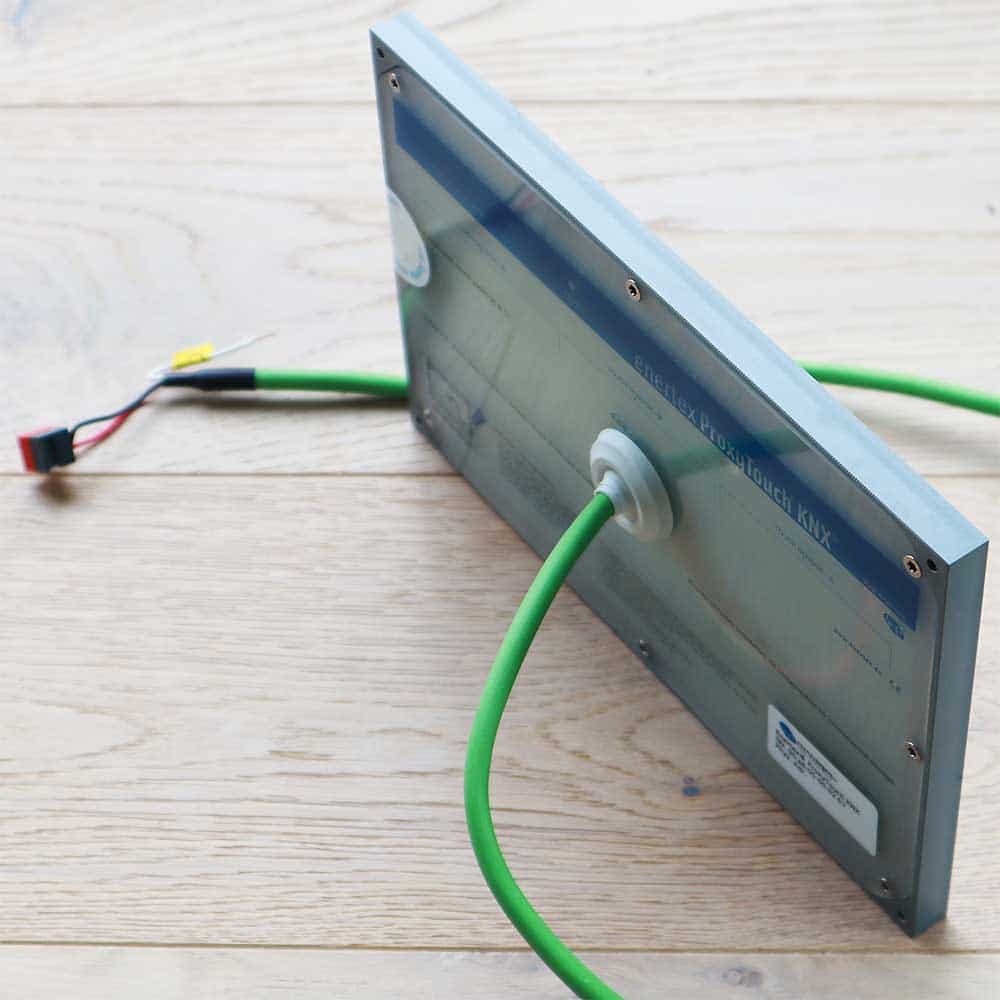
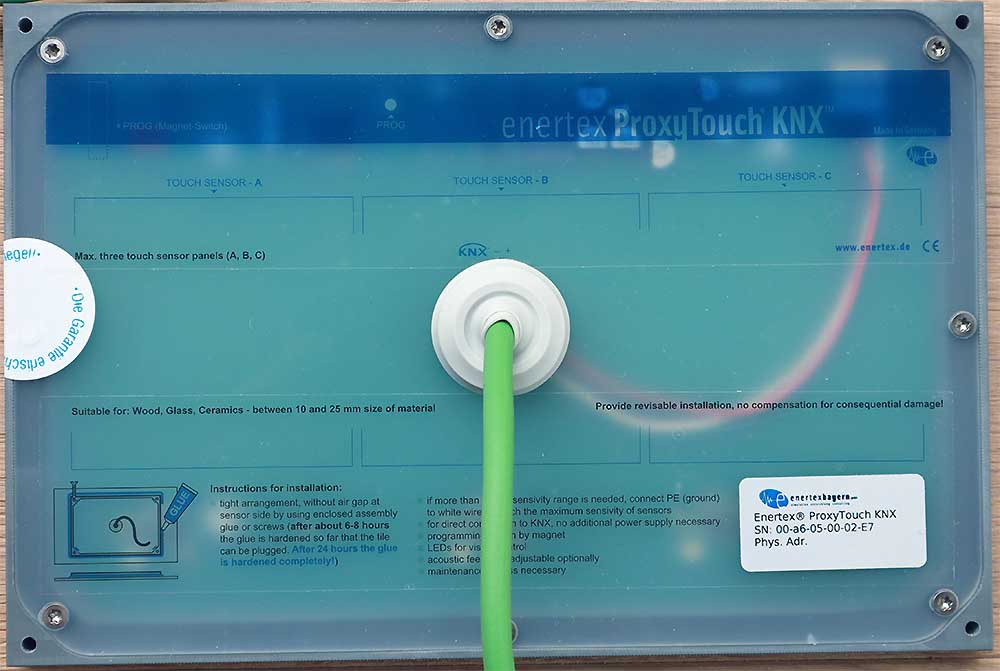
Quality and workmanship: Very good and durable
Despite the fact that the Enertex ProxyTouch is the only one on the global market for gesture control, the Bavarian company from Forchheim stays on the ground when it comes to the sales price: The well-made KNX push button costs around 250 euros, a good price considering the great equipment and offered quality. Chapeau!
Functions: Gesture control with sound output
What else is there to say about this: No other manufacturer can offer gesture control for KNX push buttons. In addition, there is an acoustic feedback when a switching function is triggered, which can also be “parameterized away” in the KNX ETS software. Of course, the Enertex ProxyTouch can also be configured as an “invisible KNX push button” without gesture functions.
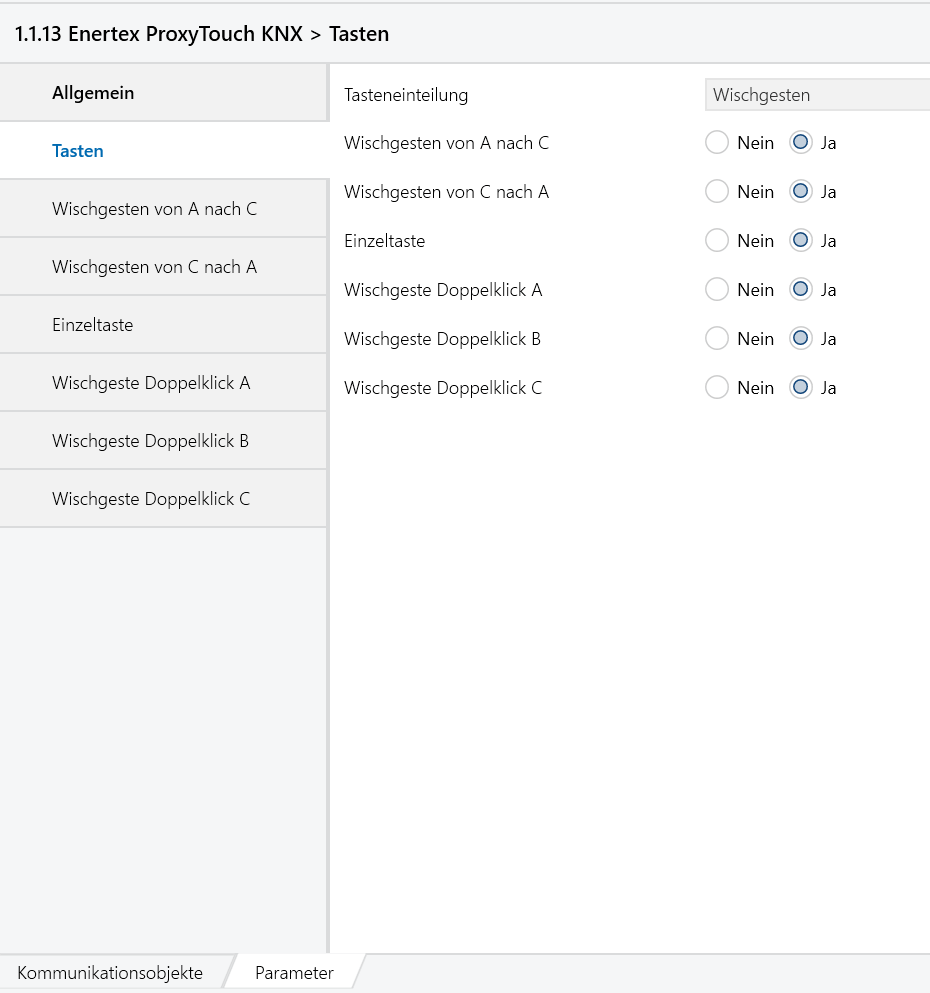
Target group: High quality bathrooms and secret safes
The invisible KNX button Enertex ProxyTouch appeals to a very special clientele: People with larger bathrooms, where the ProxyTouch is installed behind stylish tiles and draws attention with wet hands by swiping gestures. Or builders who have hidden a safe behind a painting on the wall. When you touch a certain spot on the wall, the painting moves to the side and gives access to the safe. There are other possible applications, but let’s leave it at these practical examples.
At a price of 250 euros, there is no comparable offer among the invisible KNX push buttons on the market. Conceptually, it is part of our standard repertoire for smart networked new build houses.
Gira KNX Taster: entry-level and almost a bit classy
What is there to say about this: The Gira KNX Taster is completely new on the market and has a particular focus on private builders. Or those who previously had to deal with “normal” switches from the old analog electrical world and for whom “Smart Home” was more of a foreign word. On the other hand, the design and the overall appearance of the simple KNX switch is anything but “basic”: It is available as a 1-way or 2-way version in different colors. In terms of price, the Gira KNX Taster is positioned so favorably that one would not actually have expected it from Gira – at well under 100 euros.
This is certainly the result of the growing competition in the lower segment of KNX push buttons. The black version of the Gira KNX Taster almost looks a bit classy compared to the silver version.
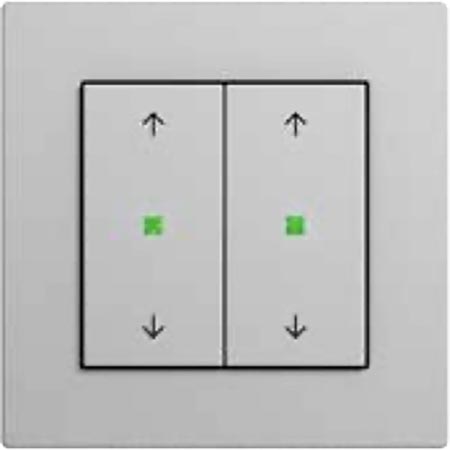
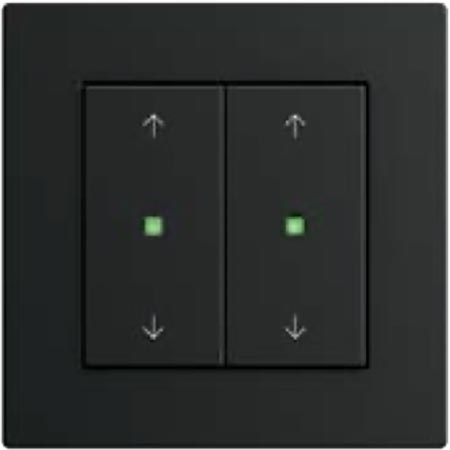
Theben iON 104/108 KNX Taster: Cheap newcomer
The German company Theben, based in Haigerloch on the edge of the Schwarzwald, is one of the founding members of the KNX standard. In view of the company’s long history, the Theben iON 104/108 KNX push button is still very young: It was introduced in 2017/2018 and is available in the variants 1-fold and 2-fold push-button sensor and as a version with room temperature controller and display.
Although the Theben iON tends to address the lower price segment, the push button is well made and offers both a defined button click and a good pressure point. All the more astonishing is the price for the top model Theben iON 108 KNX with almost three digits including German sales tax. The simpler Theben iON 104 KNX without a display and RTR is available for almost half the price. Here the Swabians from the Schwarzwald have a real bargain on offer.
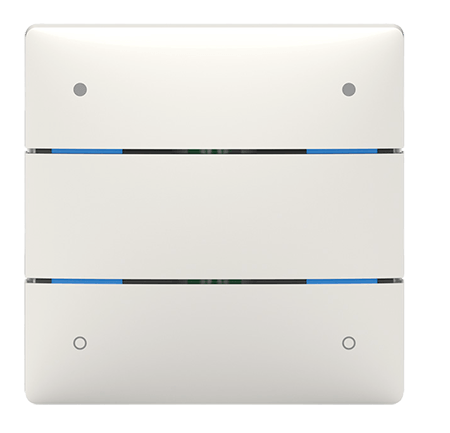
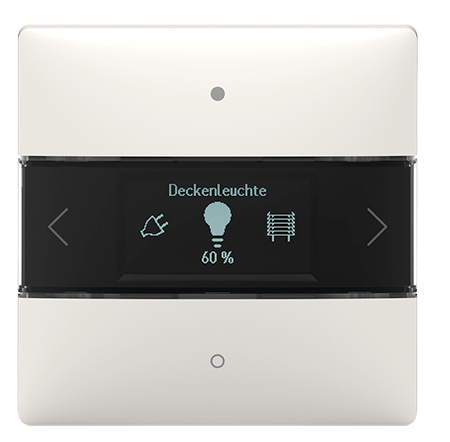
Quality and workmanship: high-quality plastic
The Theben iON 104/108 KNX Taster does not have to hide: In terms of quality and feel, it can compete with more expensive plastic buttons such as those from Gira or Jung. We quite like the slightly rounded edges and subtle sheen of the plastic.
Functions: temperature sensor, status LEDs and KNX Secure
With the Theben iON KNX Taster, it is easy to see that their basic development dates back to 2018: The data encryption KNX Secure is supported, which most of the KNX push buttons in our large comparison cannot yet offer.
Compared to the competition, Theben, as a newcomer/manufacturer in the KNX push button environment, offers a choice of three different functions for each individual button: short, long or double clicks can be set. The same applies to the selectable colors of the status LEDs, which can pulsate, flash or shine continuously.
Target group: Beginners who are looking for good value for money
At first glance, the Theben iON 104 or 108 is fairly inconspicuous as a KNX push button with/without display. A second look shows that there is good equipment at a very good price – even under 100 euros. The processing of the plastic button is definitely right and the version with a display can definitely compete with the more expensive competitors – also from Germany.
Many customers will opt for the good Theben iON 108 for room control as part of the “KNX Light” version from Theben – LuxorLiving.
Basalte Chopin: piano keys on the wall
The Basalte Chopin is clearly aimed at the luxury segment. It finds its way into venerable villas that are networked with KNX and brought up to date with the latest technology or in high-quality new build houses of the upper class.
Among all the KNX push buttons, the Basalte Chopin has a special role: The operation and button shape are very reminiscent of a piano. We have not seen anything like this in the KNX environment in the past 16 years! Then there are the almost limitless ones
Possibilities of individualization in the choice of shape, design (single/double, lengthwise/crosswise etc.) and the choice of material: As with the other Basalte KNX push buttons (Basalte Sentido, Fibonacci, Deseo), the Basalte Chopin can be configured in 12 different real metal variants become. Among them are also very noble combinations in Fer Forge (hammer blow) or shiny brass (gold) with a heavy metal plate made of bronze, brushed aluminum or copper rose.
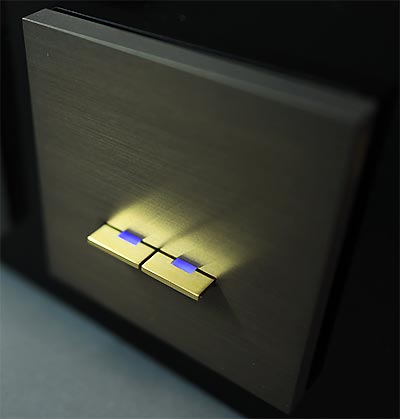
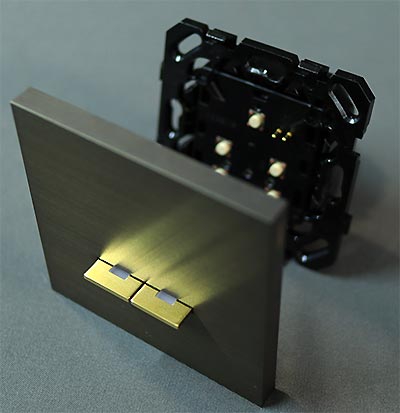
Quality and processing: High material quality and fit
We have been testing the Basalte Chopin in practice for quite some time. We also took the opportunity to test the functions in combination with different metal surfaces and colors. The “keyboard stop” – that’s how it has to be described – is very defined and can be triggered precisely and with slight resistance in both directions. Fingerprints cannot be seen and the material quality can be described as extremely high quality.
The fit tolerances are in the low tenths of a millimeter range and convince even very demanding people who are quick to complain about small things.
Functions: temperature controller and status LEDs
What is not visible at first glance: The Basalte Chopin offers 10 button functions via two piano rockers, offers optionally illuminated status feedback in freely selectable colors and has a complete integrated temperature controller for KNX heating control. Everyone has to decide for themselves whether the latter really still makes sense today and is needed.
If that is not enough for you, you can parameterize the Basalte Chopin in the KNX ETS software so that the cool scene sequencer (known from the Basalte Sentido) also offers four different color codes to choose from and select. This turns the inconspicuous little mini piano on the wall into a room control that only larger KNX push buttons with many more control elements can offer.
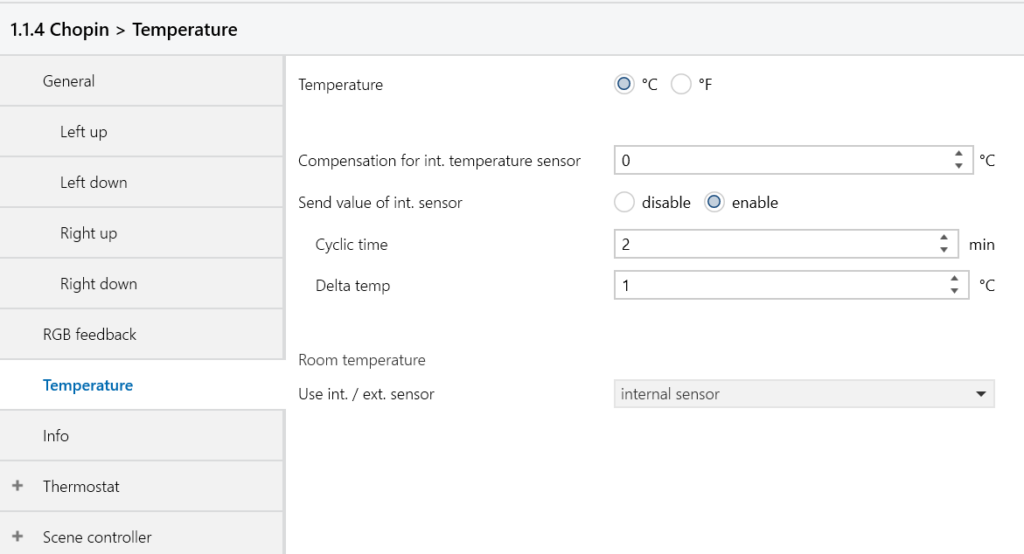
Target group: high-end luxury with a special status
The Basalte Chopin goes its own way in the environment of the high-end luxury class, in that the piano-shaped keys, its material appearance, the almost limitless possibilities for individualization and the technical equipment currently have no competition on the market. If you place great value on the interior design, colors and ambience of any room, you should shortlist the Basalte Chopin. The basalt Chopin cuts a fine figure in a venerable Smart Home Villa. Because the customization options are perfect, as are the underlying KNX technology and functionality.
At just under 400 euros, the equipment/individualization with Basalte Chopin starts and ends at just under 600 euros.
Positioning of the KNX push buttons Manufacturer: Basalte to MDT
The graphic below provides an overview of the positioning of the individual brands/manufacturers on the market for KNX push buttons. It is the result of our many years of practical experience and thus our own assessment. After all, there are 83 different manufacturers on the market who offer just over 1100 KNX push buttons. That’s an average of 13 different push buttons/variants per manufacturer!
The graphic below lists the most relevant manufacturers for KNX push buttons for the German-speaking area (DACH = Germany, Austria and Switzerland). There are a number of other manufacturers, but they are out of the question for us in terms of availability in Europe and quality/design.
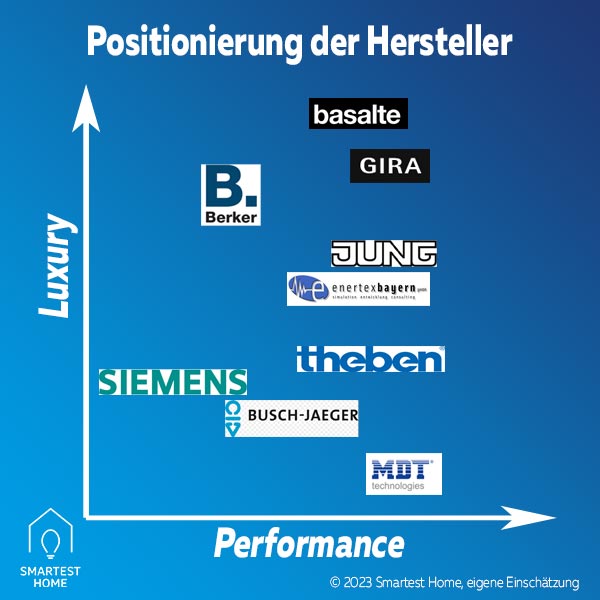
The benchmark for all KNX push buttons is, on the one hand, the technical equipment that is offered, which is expressed in the range of functions and increasingly integrated sensors. On the other hand, a high-quality look and feel is at least as important for many builders.
After all, there is no other smart home system in the world with such a wide range of colors, material selection, surface feel and design. Ascending trend! While Basalte in particular and meanwhile also Gira and Jung (but not exclusively) position themselves more in the upper segment, MDT, Theben and, for example, Busch-Jaeger address the broader market for new build KNX Smart Homes.
Note: The graphic above shows a section of the market for KNX switches and KNX push buttons.
What do all KNX switches for Smart Home have in common?
In the newer and current KNX push buttons, the bus coupler is always integrated. This was not the case in the past (approx. up to 2010) and the bus coupler had to be purchased for approx. 35 to 45 euros per push button. Here the market has clearly developed in favor of builders, today there are many more KNX components for significantly less money than 10 years ago!
Due to the constantly increasing equipment and the need for higher living comfort, the construction costs continue to rise.
If we were to equip a family house today like it was in 2015, the costs for the KNX push buttons alone would be significantly lower. Today there is much more equipment for less money.
How much does a KNX push button cost? Where do the price differences come from?
That’s a large price range for KNX push buttons. Depending on the material (metal, plastic, wood), the surface feel and the functions/equipment (additional display and number of sensors), the price varies between around 80 euros and 1,000 euros. The push buttons that we have tested here in practice and have been in use for over 16 years are definitely recommended – with their respective strengths and weaknesses.
There are also different distribution channels. Some manufacturers, such as MDT, sell directly to builders via online trading and thus save themselves the entire field service. This means that the electrician, who usually carries out the electrical installation in a house, has less profit margin with the material. Because the builder/end customer pays the same price as the electrician. Other traditional German manufacturers such as Gira, Jung, Busch-Jaeger and Theben sell their KNX push buttons in a three-stage system via wholesalers and have their local representatives throughout Germany. Large online dealers with their own warehouse now buy directly from the manufacturers mentioned and thus operate in 2-stage sales.
Manufacturers in the high-end segment, such as Basalte from Belgium, sell their KNX push buttons exclusively through selected Basalte Pro partners, who also have the relevant practical know-how and experience in dealing with the demanding clientele.
Which surface for KNX push buttons is right for me?
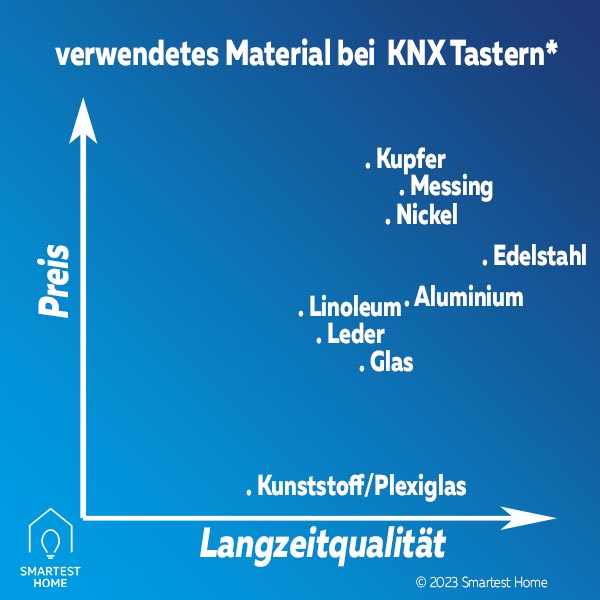
When choosing the material for the right KNX push button, there are definitely connections between long-term quality and price: While the KNX push buttons made of plastic – regardless of the manufacturer – are offered fairly cheaply on the market, the versions made of stainless steel cost significantly more and are therefore very durable. Versions made of aluminum or glass are slightly cheaper in price. The exotic ones still include KNX push buttons with a leather surface, which can currently only be found on the Basalte Enzo (black or white leather). Gira is breaking new ground with the optional use of linoleum surfaces.
And what is meant by long-term quality? In the case of the plastic KNX push button, the color will change over the years and will no longer look quite as fresh as on the first day. However, this has no effect on the functions. With normal use, you can easily expect a service life of 25 to 30 years. There is no longer customer experience as the first KNX Smart Homes date from 1998 to 2000.
Encrypted KNX push button: Why KNX Secure?
The KNX push buttons we have presented here and most of which have been extensively tested in practice are not all available with the “KNX Secure” encryption. In order for the encryption (AES128 algorithm) to function properly and be applicable in the KNX network, at least two participants – usually a KNX push button and the associated KNX actuator – must support the new encryption standard KNX Secure.
This means that the communication between the KNX push button and actuator can neither be manipulated nor interpreted.
Is that possible: KNX push button outdoors?
A frequent question arises with most builders: Can I place KNX push buttons outside, such as in the garden, terrace, pool, tree house or garage? Very clear answer: No! Basically, KNX push buttons only belong in the interior of the house, if only because of the security against sabotage and the protection against environmental influences such as moisture, solar radiation or frost. An exception could be a separate KNX line for a special KNX push button that is in a “secret” position. If, as expected, an external attacker gains access to the KNX system via the external KNX push button, the connection on the separate KNX line should always be encrypted (KNX Secure).
How many KNX push buttons in a family house?
In the conception and KNX planning phase of a house, the question of the total number of KNX push buttons that are required in a building is clarified. We often use at least one KNX push button per room, although it always depends on the individual situation and the size of the room. In larger rooms from 20 square meters (e.g. in the kitchen and living/dining area), one push button is usually no longer sufficient. Smaller rooms such as toilets or storage rooms can also do without a KNX push button.
At what height is a KNX push button mounted?
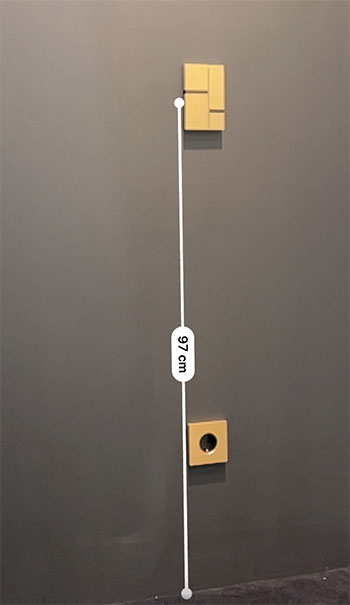
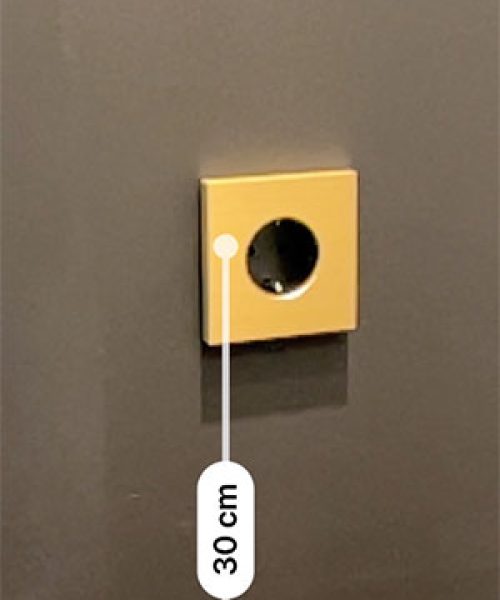
This question often arises for us during the conception and KNX electrical planning with builders: At what height should a KNX push button be mounted in the room? What is the recommended mounting height? In principle, there is no difference to a conventional switch: the installation height from the upper edge of the finished floor should be between 1.20 and 1.30 meters (frequently abbreviated in CAD architect plans: “OK FFB”).
The point is that all residents of the house can easily reach the KNX push button for operation and, if available, can read the display easily. If there are children in the house, they should also be able to operate the KNX switches.
A special situation arises when KNX push buttons are installed in cupboards (e.g. kitchen, hallway or bathroom). Then the mounting height can deviate from the above recommendation and be completely individual. In the bedroom, for example, KNX push buttons can be placed at a height of 0.6 meters (top of floor) on the bed.
Top 5 KNX push buttons from 16 years of house building practice
In the above video we present you the “Top 5 KNX push buttons” of the past 16 years from our point of view and experience – more about this in the article “Smartest Home Story”, which is about our own KNX history and history. And an important note: These top 5 KNX switches are a subset of the “Top 30 Longlist” in our overview, which is constantly kept up to date.
